This email from last week stopped me in my tracks (please excuse the typos, I’m keeping this fresh and authentic):

We’ve got a ton of guides on how to build your email list. Grow your site from 0 to 10k visitors, best places to collect opt-ins on your site, 85 ways to build your list…the list goes on and on.
But, believe it or not, we didn’t have a guide explaining how to write irresistible sales emails that make anyone purchase anything.
Well…until NOW.
See, your list isn’t worth a heckuva lot unless you do something with it. Traffic is well and good, but if you can’t get your list to buy anything then you’re basically just a content outlet, publishing until you slowly run out of money.
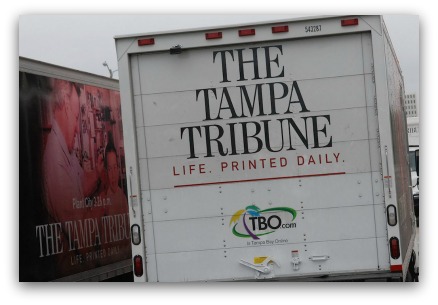
So a newspaper, essentially
Eventually, you have to make the big ask. Gary V calls it the right hook (sell) after you throw the jabs (free content). If you’ve provided enough value, you should be able to ask someone to purchase.
That’s where sales emails come in.
We write these kinds of emails all the time at Sumo. We’ve seen single emails bring in over $100,000 in a few hours. And we’re not the only ones — guys like Dan Kennedy have pulled in over $1,000,000 from an email.
But how do you write that kind of sales email?
Just a quick heads up: this guide is 11,000 words long. If you want to save some time and download the eBook (and get a bunch of free sales email templates derived from Ramit Sethi, REI, Brian Dean and more), just click here.
Trust me, it’s a hard email to write. And if you Google “how to write sales email” you’ll see tons of courses dedicated to this very specific and important type of email. Here’s the problem with those:
-
You have to pay for them: Sometimes it’s $100 per course. Sometimes it’s over $1000. That’s a lot of cash for a template.
-
It takes a lot of time to learn: I’m talking hours upon hours of going through videos, audio files, PDFs or whatever they give you.
-
They teach you how to write one type of email: Most of these courses teach you how to write one type of email that worked for the course creator. Then you copy that one specific technique and use it forever.
Here’s the reality — writing a sales email doesn’t have to be that hard. You don’t need to pay hundreds of dollars to learn one technique, and you can actually write a successful email in a few minutes.
How? Read this guide. Because I’m going to do three things for you:
-
Reveal why every sales email can be boiled down to 6 distinct types: Each individual email is different, yet they all fall into one of 6 categories.
-
Dissect successful emails and show you what works: I’ll break down real-world emails and show you the repeatable formulas you can use in your emails.
-
Give you email templates you can use today: I’ve got templates based off the emails I’m about to show you. They’re proven to work and all you have to do is download them and enter your own unique information.
It’s free, it’s easy and if you still can’t write your own email I give you the actual templates to fill in. And remember, we’re talking about selling something, so these templates will focus on selling in the email or driving to a landing page.
One quick warning before we jump into the emails…
WARNING: You need to know your audience before you use these emails
This isn’t one of those “Warning: make sure you have space in your closet for fancy suits because after reading this guide you’ll become a millionaire” fake warnings.
This is a legit warning. I’m about to break down a lot of different emails. They all work, so you might be tempted to try every single one of them.
Don’t. Even though every email is effective, they’re effective for their respective audiences. Ramit Sethi’s long emails? Great for him, but maybe not for Old Navy.
If you send tons of short non-sales emails, it would be weird to suddenly send a massive, 1,000 word beast of an email. Your first few thousand subscribers are more attuned to your style of writing, and big changes will feel disingenuous to them (aka they can smell the bullshit of fake writing).
As such, keep in mind your style of writing when you read these templates. There’s a difference between copying a template a few times and sustaining that style. Be aware of what your audience is used to and don’t abandon that.
Alright, scary ominous warning OVER. Let’s get into the goods.
The 6 Types of Sales Emails Everyone Writes
Sales emails are kind of like my dad’s dance moves — there are only six types, and they’ve been highly refined over the years.
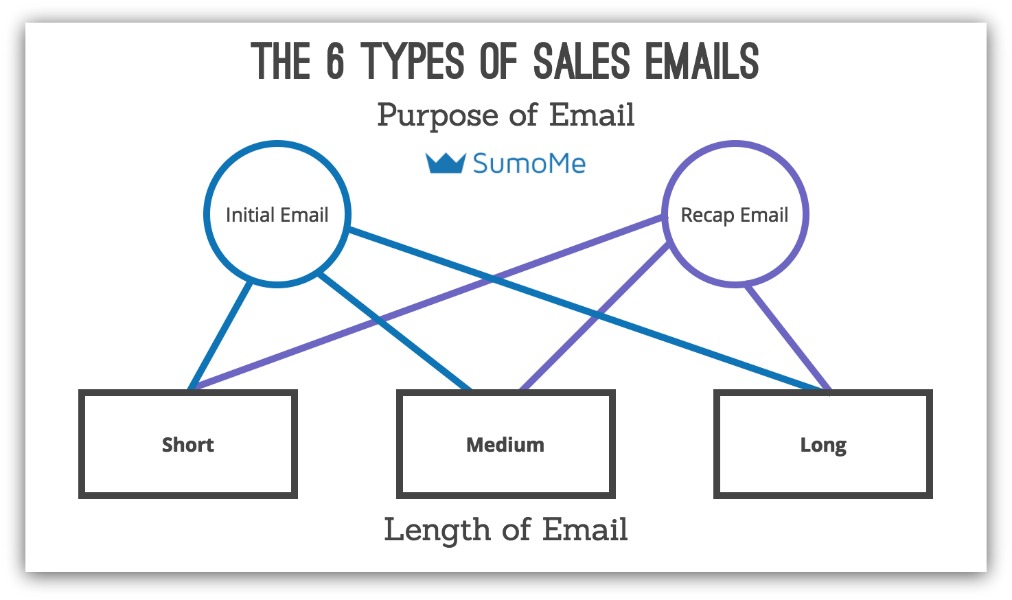
You see that there are two main email categories — type and length.
Type Of Sales Email
Type, in this instance, refers to one of two emails you send at a specific time:
-
Initial Email: This is the first email you send to alert people of your offer.
-
Recap Email: This is the email you send to remind people your offer is ending soon.
You see initial sales emails all the time. They announce your offer for the first time to your audience:
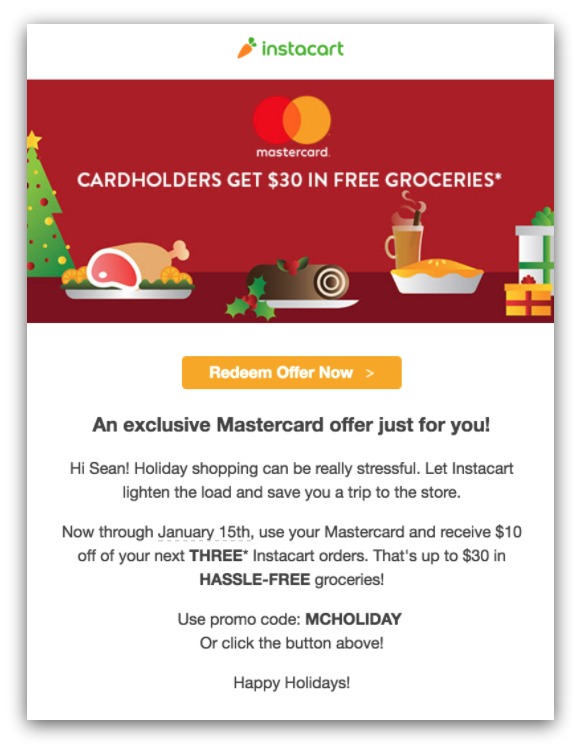
This is what you normally think of when someone says sales email. The company (in this case, Instacart) has an offer, and they’re alerting you about it. Pretty straightforward stuff.
Then there’s the other type of sales email — recap emails. It might sound strange and unfamiliar, but you see these all the freaking time:

These are the emails that signal the closing of an offer. A lot of first-time emailers forget this kind of email, but seasoned pros lean on this email to generate tons of sales.
Why? Because of urgency. When you have unlimited time to buy something, you put it off until it become urgent. BUT, if you only have a few hours to to buy, you become much more likely to buy. See Friday, Black.
If your inbox is anything like mine, you see a lot of variations of this email:

Here’s the ever-popular “Last Chance” email. It’s your last chance to act on the offer, because it’s going away soon. Though you could substitute “Last Chance” for “X Hours Left” and the sentiment is still the same:
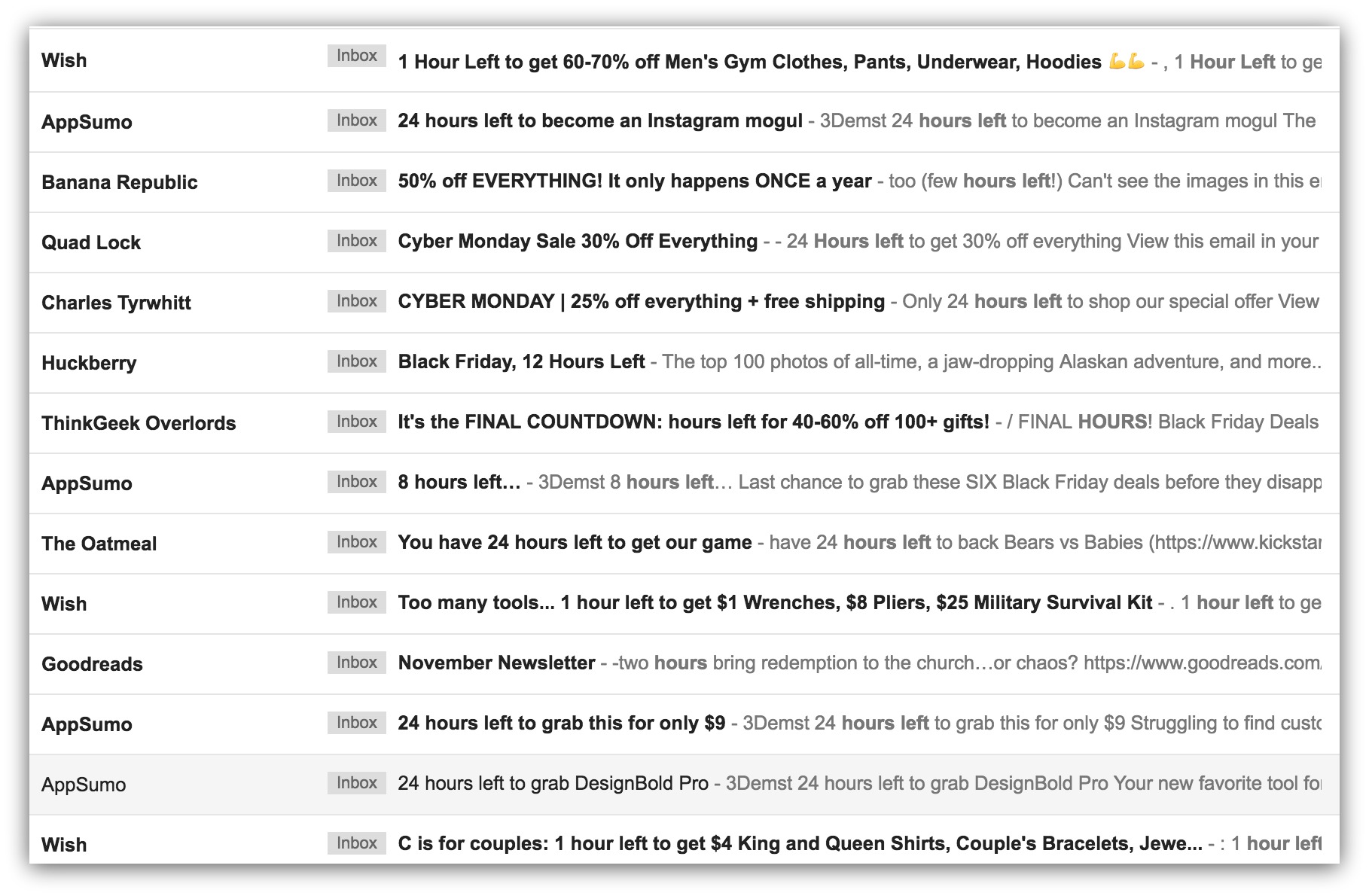
Funny enough, these recap emails make as many or more sales as the initial email. We send these quite a bit at Sumo, and the recap emails are an absolute lynchpin in our email strategy.
Launch your sale with the initial email, but don’t forget to wrap it all up with a recap email. These two emails combined can score you tons of sales.
Length of Email
Turn to your coworker and ask what length of email they think works best. I guarantee you’d all come back with different responses.
And there is no right or wrong answer. Length of email is divisive because of its subjectivity. One minute you may read a book proclaiming the value of long-ass emails. The next minute there’s a massive article showing short emails running the land.
Neither are wrong. Because when it comes to sales emails, there are three distinct lengths that get results:
-
Short: 10-50 words
-
Medium: 50-500
-
Long: 500+
These are the general wordcounts for the three lengths of sales emails. The numbers may seem hard to imagine, so here’s a few examples. First, there’s the short email:
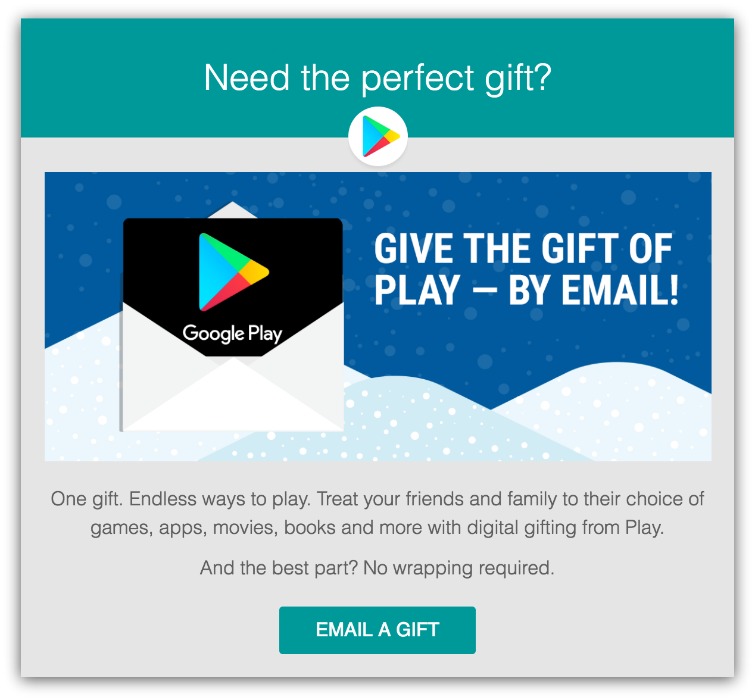
Nothing fancy, just a few well-chosen words and a call-to-action. Then there’s the medium-length email:
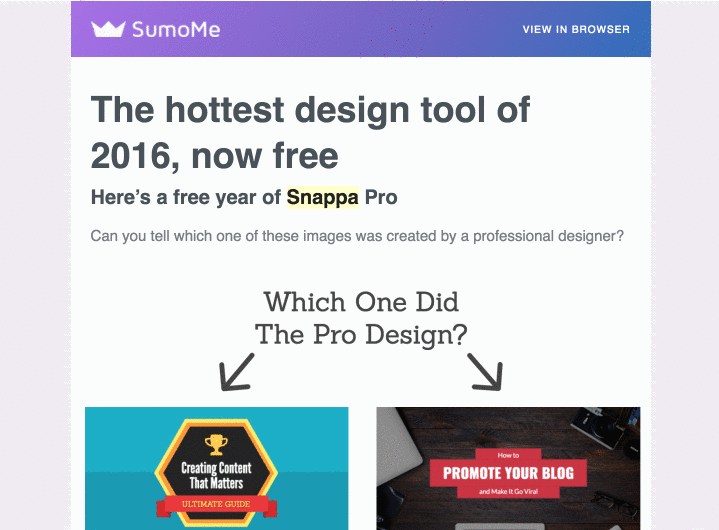
There’s a bit more going on in this one, with multiple points that drive to a call-to-action. Finally, you’ve got the long email:
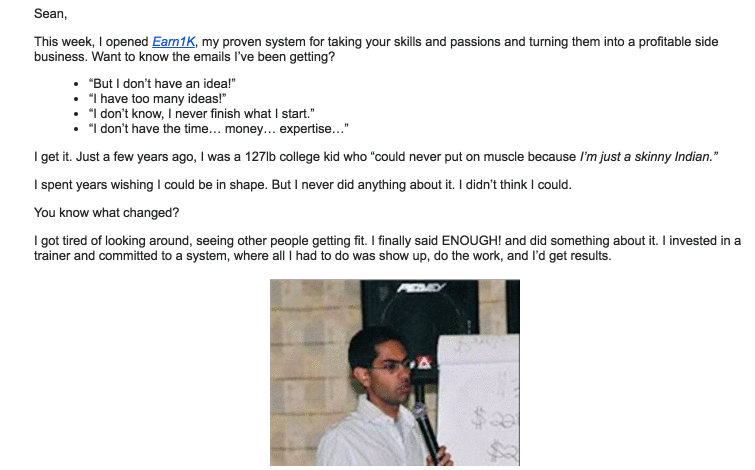
This beast from Ramit Sethi clocked in at 1,500 words (not including all the text on the images).
The funny thing is, even at a glance you can see differences in the design/layout of each email based on word count. The length of your email says a lot about what you’re trying to sell, which is why each length has a distinct look and feel.
So remember, there are two types of sales emails — initial emails and recap emails. And there are three lengths of sales emails — short, medium and long. The real magic comes when you start combining these
Let’s make some magic.
The Short Initial Email: A Staple for Every Ecommerce Business
This might be the most commonplace sales email of the six I’ll talk about. But the reason it’s everywhere is because it takes the least amount of time to write while still providing maximum results.
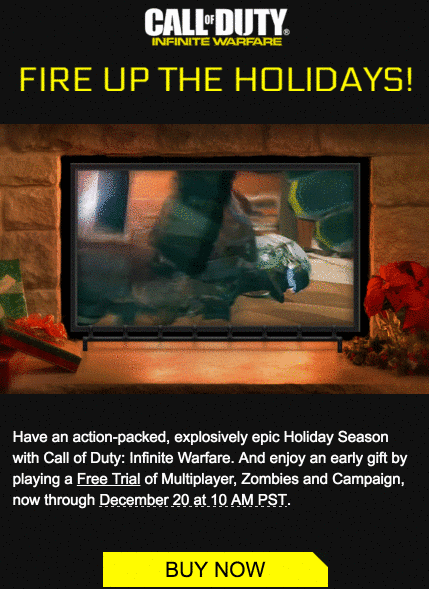
Even if you spent a two hours making sure your 40 words are the best ones possible, you’d still spend less time on this type of email than one with 500+ words. And in a world where the average person gets 121 emails per day, getting to the point is highly appreciated.
Pros of the Short Initial Email
- Easy Test For Gauging Interest: Since this is an initial email and it doesn’t take long to create, it serves as a great test for measuring interest on your offer. If initial purchases are high, you know you can roll out a similar recap email. If initial purchases are low, you know you need to change up the messaging in your recap email.
- Higher CTR: If you have to read (see: scroll) less, you decrease the chances of someone exiting your email and increase your chances of them clicking on your call to action. The barrier to click for the reader is low because there isn’t as much to read.
- Great For Discounts: Due to the short nature of these emails, they’re tailor-made for discounts. They don’t need much explanation and you get straight to the point.
- Quick to Write: This is obvious, but 10-50 words takes less time to write than 500+ words. The point being, you can finish this type of email sooner, leaving you more time to work on other things.
Cons of the Short Initial Email
-
Need to be Well Known (Brand or Product): Most of the emails in this category come from well-known brands or companies with well-known products. They don’t need to say a lot because they assume you’re already familiar with their offer. If you aren’t sending to people familiar with your or your product, you could experience low click throughs due to that unfamiliarity.
-
Hinges on Strength of Offer: You’re naturally focusing on your offer when you operate with so few words. If you don’t have a great offer then you’ll definitely feel it when you check your click through rates. Only great offers get substantial attention in a short initial email.
-
Might Be Too Little Information: Fifty or fewer words may not be enough to sell someone if your product or offer is complex. These emails are short and succinct, leaving no room to explain your offer in-depth.
The Anatomy of A Short Initial Email
You’d think an email with 50 or less words wouldn’t have a lot to talk about. You’d be wrong.
Even though it’s a short email, there are a lot of intricacies packed into this short message.

Element #1: The Logo
At the tippity top of every short initial email is a logo. It’s not there for vanity purposes (though the bigger the logo, the more I question that statement). It’s simply a slight visual reminder of who the email is from.
While you could get away with excluding your logo, there’s really no reason NOT to include it. It takes up very little space and provides a nice branded touch to your email.
Element #2: The Headline
The headline is one of the more important areas of this kind of email. Basically, it serves two purposes:
-
Tease the Value Prop: This is usually the first thing your reader sees when they open the email. Your headline draws the reader in by alluding to the value proposition.
-
Modify the Subject Line: Modify, in this sense, means build off of. If your subject line was straightforward, you can be a bit more vague in the headline. If your subject line was more vague, your headline needs to clearly communicate your value proposition.
Without diving too much into email technicalities (that’s a whole other guide), your headline will appear after your subject line in inboxes:

That’s the grey part after the black subject line. Since it’s usually the first text in the email, inboxes will pull that text and show it in your inbox. That’s why you sometimes see messed up subheadlines like this:

See how that doesn’t look like a sentence? That’s because the inbox is pulling the first text it can find. When you write a headline that makes sense, you end up helping your reader because they can know more about your email at a glance.
Element #3: The Image
If the headline is one of the more important elements of this email, then the image might be the most important element. It carries multiple roles and can actually make other elements of the email unneeded.
In the Dropbox example, the image is used for one purpose — to add some visual fun and reflect their lighthearted branding. If you aren’t using your image to fulfill other roles, then your image should meet the bare minimum — to be a reflection of your brand or show off your product.
However, most people use their image to act as three things: showing off the product, communicating the offer and being a faux call to action.
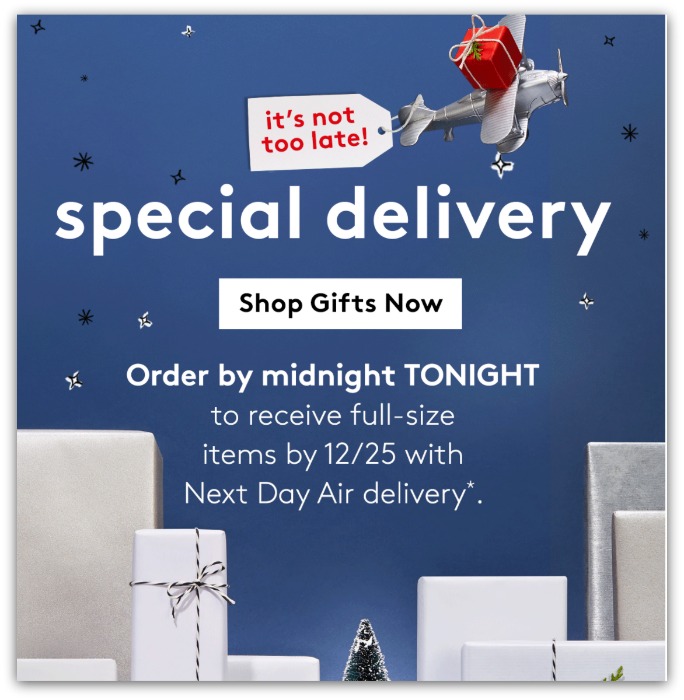
Here’s an email from Birchbox Man where the image acts as a container for everything — the headline, the call to action (if you click the image you go to a new page) and the sales text.
Sometimes the image doesn’t have the call to action, yet it still displays the product while conveying the offer:

Every image shows the product or reflects the brand at the very least, while a good many let the image do more work by giving more function like sales text or calls to action.
The thing to note is how the sales text on images are usually for physical products (and mostly discounts). When it comes to services, digital products (like Dropbox) or any non-physical goods emails, the sales text is where the magic happens while the image stays simple.
Element #4: The Sales Text
If you didn’t use some word magic on your image, then the area below the image — your actual sales text — is the battleground for determining if your reader will click through or not.
Here’s the biggest thing to keep in mind. Most short initial emails give away a discount. That’s due to the nature of writing under 50 words. You don’t have a lot of space to follow any sort of traditional writing formula. But discounts don’t need a lot of explanation.
For the ultra short emails, you write the bare minimum:
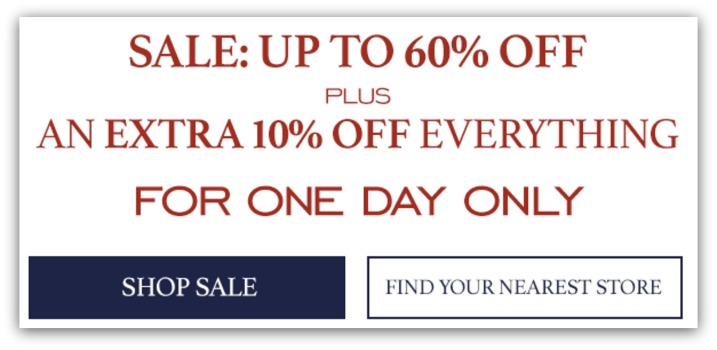
You just say what the discount is and how long the deal runs for. Nothing crazy complex and it doesn’t need much explanation.
If you have a little more space, you can follow the Dropbox super-short formula of problem, solution, offer:

Here’s how it breaks down:
-
The first line is timely (Black Friday) and presents a problem.
-
The second line brings a twist and offers a solution.
-
The third line is the discount and the time frame.
The fourth line you could take or leave, but that’s just a matter of feeling like you need to put something after the offer (you don’t).
In the rare case you’re using a short initial email to offer something OTHER than a discount, you’d still follow the same formula — problem, solution, how to get the solution. The assumption is you’d have a long-form landing page that can explain your offer.
Either way, the text ends up being more straightforward and simple as opposed to drawn out and flowery.
Element #5: The Call to Action
Funny enough, the call to action in a short initial email needs to follow two specific guidelines.
-
Use A Colored Button: When the email is this short, you don’t want people to guess. A colored button stands out far better than a link, drawing your readers’ eye to your call to action.
-
Repeat Your Offer (Under 6-8 Words): The rule of thumb is this — if your reader saw nothing but the call to action button, they should know exactly what they’re getting.
What do you see when you look at all these buttons:
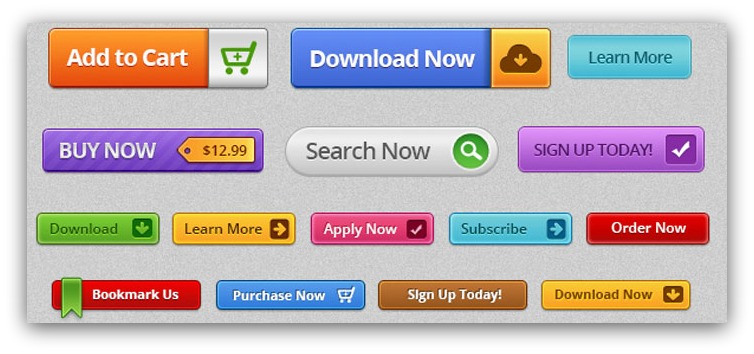
Everything is extremely straightforward and stands out. You can read these buttons and know exactly what you’d get if you clicked. It’s kind of like the TV commercial rule: if the TV was muted, would you be able to get the meaning of the commercial?
Same thing applies to buttons. Make it easy to understand and you’ll get higher clickthroughs.
The Short Recap Email: Turning Urgency Into Irresistible Offers
Good news. If you already wrote a short initial email, then this part will be a breeze.
The recap short email is the easiest of the six emails to write. That’s because you’re taking your core message and just injecting some sort of urgency.
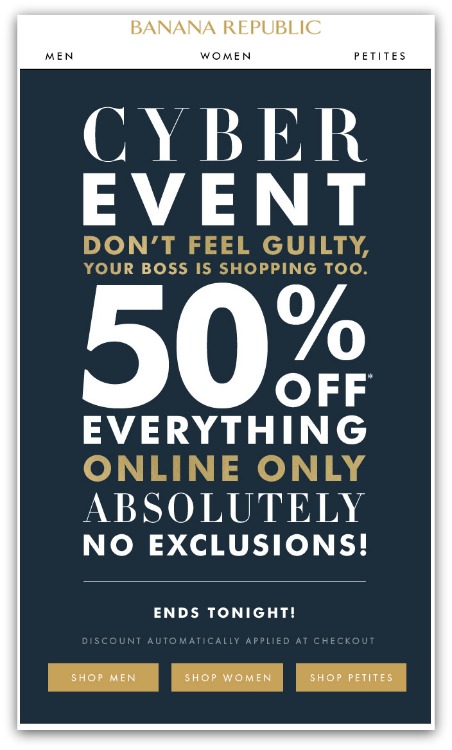
The urgency is always one of two things — time or quantity. When either of those things run out, the sale is dead. It’s an extremely powerful motivator because no one wants to be on the wrong side of a sale they wanted.
Pros of the Short Recap Email
-
Still High Click Through Rates: There’s not a lot to read. Since this is the last time your deal is offered, people will read the email in a few seconds and either click or not (most times they click).
-
Huge Emphasis On Urgency (More Sales): This format places emphasis on urgency in its purest form. There aren’t tons of paragraphs reiterating the urgency. It’s just there, in your face with absolutely no clutter.
Cons of the Short Recap Email
-
If Your Short Initial Email Was Bad, This One Will Be, Too: The advantage of a short email is the emphasis it places on the actual offer. If no one claimed your offer in the initial email, and you still march out the same offer, then you’ll get the same result.
-
Might STILL Be Too Little Information: Fifty or fewer words may not be enough to sell someone if your product or offer is complex. These emails are short and succinct, leaving no room to explain your offer in-depth.
The Anatomy of A Recap Short Email
This part is short and sweet. The recap short sales email still retains almost all the elements from the short initial email: the logo (1), headline (2), image (3), sales text (4) and call to action button (5):
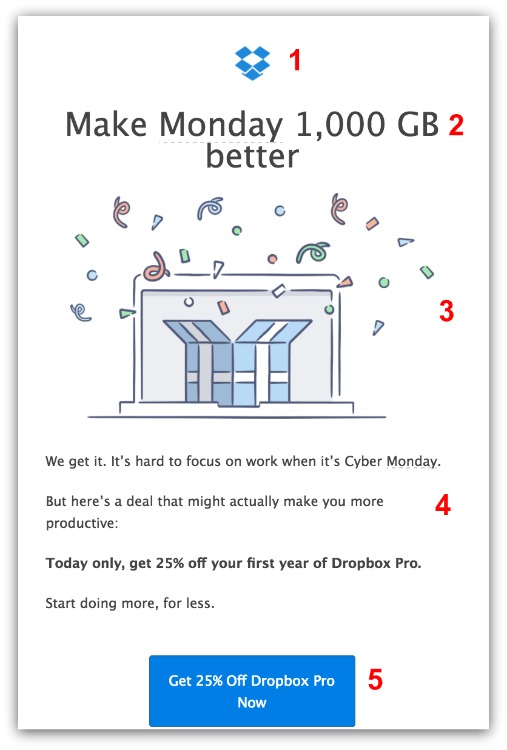
However, there’s just a slight modification. In either the headline, image or sales text, you’ll see a clear focus on urgency.
Sometimes it’s in the headline:
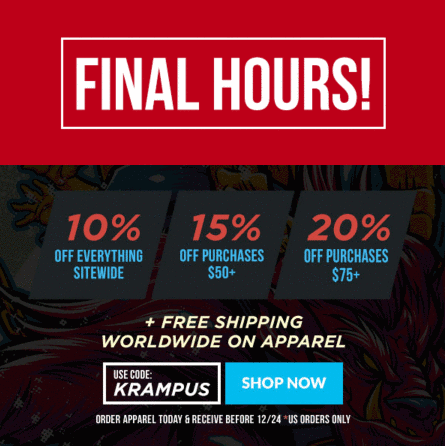
Sometimes it’s in the image:
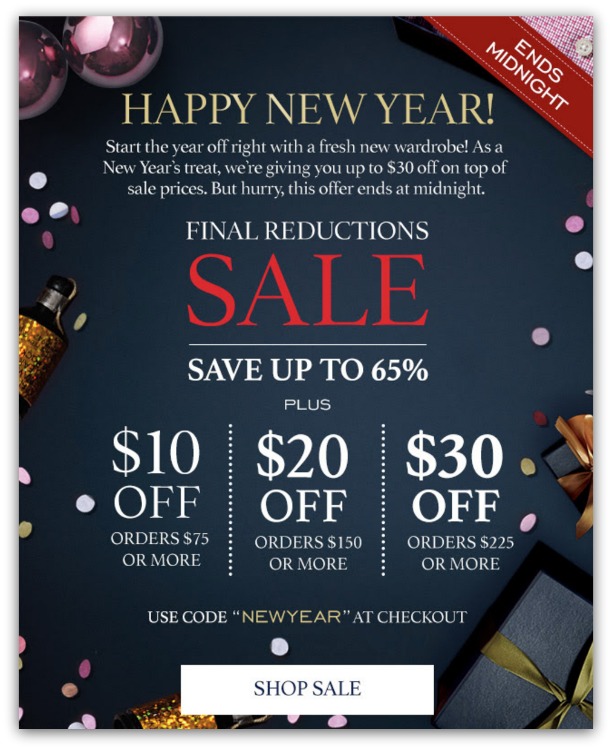
And sometimes it’s in the sales text:
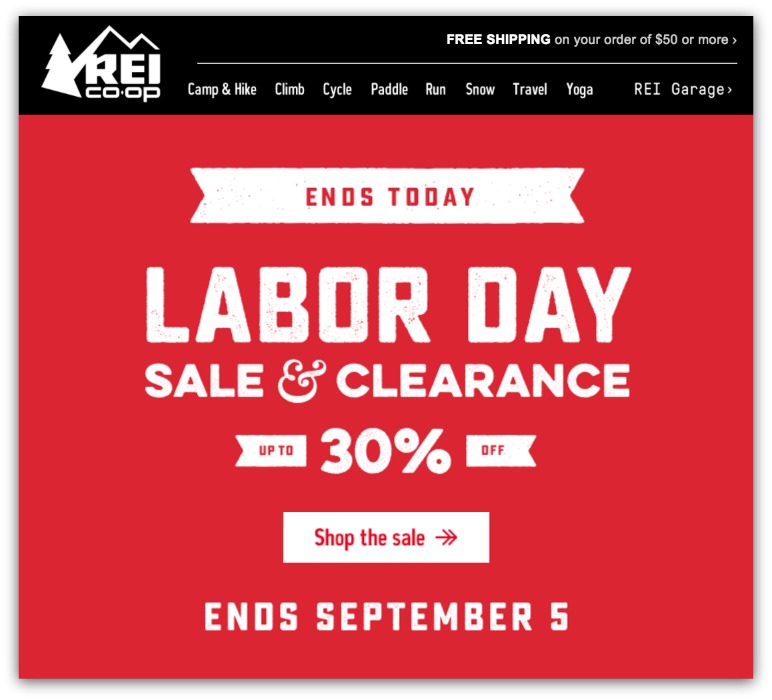
No matter your placement of choice, the fact remains that urgency is apparent in each email. And the biggest thing to note is the timeframe of these urgency appeals: most GOOD recap emails give you 24 hours or less to act.
Why? Because it becomes a priority for that day. Whenever you give longer than 24 hours, you give your reader an excuse to “put it off til tomorrow.” If that happens, kiss your sale goodbye because procrastination will render your message worthless.
But anything under 24 hours gives your readers a reason to act now. It feels more urgent. They can’t put it off til tomorrow. They read your email and stay in it longer because they feel like they have to do something. Some of the more common urgency phrases you’ll see:
- Ends tonight
- Final hours
- One day left
- Ends at midnight
- X hours left
That urgency, combined with the brevity of a short sales email, turns this recap email into an irresistible, act-now offer.
The Medium Initial Email: The Modern Way To Persuade A Reader
Lean in, because I’m about to tell you a secret…
This the email you should get most familiar with, because it’s the one you’ll use the most.
This is kind of like the Swiss Army Knife of emails. Since you’re writing anywhere from 50-500 words, the message can take on a variety of forms. The main thing to remember is you get a lot more room to describe and, ultimately, sell your product.
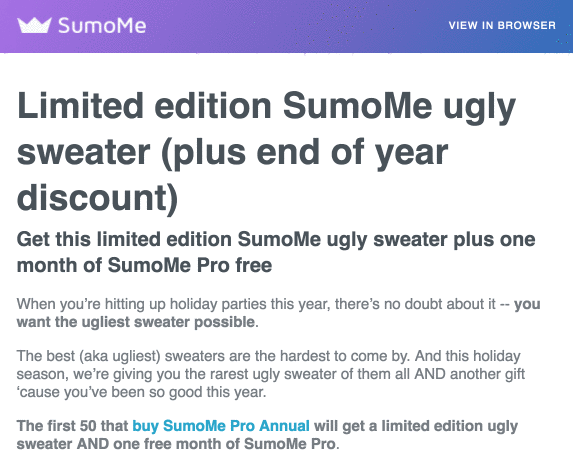
This versatility comes with a huge set of advantages (and some obvious disadvantages). But if you’re going to write these emails in the near future, it’s best to learn where you can win and where you need to shore up.
Pros of the Medium Initial Email
-
Flash Your Personality: So many emails end up reading like the same damn person wrote them. Medium emails give you the chance to inject your brand and stand out in someone’s flooded inbox.
-
Multiple Appeals to Buy: Shorter emails rely on urgency to get sales. Urgency is great in any email, but medium emails open you up to even more appeals — social proof, appeals to emotion, logical approaches, etc.
-
More Space to Sell: In short emails, you rely on the strength of how your offer initially looks. With a medium email, you can give context to that offer. You get more room to explain the offer, show why your reader needs it and then go for the throat with the ask.
-
Lots of Flexibility: You had 50 words in the short email. You can’t do a ton in that space. In this medium email you have considerably more flexibility as to what you say and how you say it. That length gives you more opportunity to create a unique message.
Cons of the Medium Initial Email
-
Lower Margin For Error: The longer your email goes, the higher your chances of readers closing your email without acting. You need to be compelling from the first word to the last. Anything less and you may have wasted half your email.
-
Some Grasp At Writing Well: Kind of obvious here, but you can’t fake your way to a compelling 200 word email. Fifty, maybe. But these medium-length emails require some semblance of writing ability.
-
Takes Time to Write: Writing a sales email can seem daunting once you get past two paragraphs. If you’re starting out or even slightly experienced at writing emails, this type of email will take a few hours to write. And even more to edit.
-
Must Know Sales Flow: You can’t just write on and on about how your offer is great and people should buy it. You need to know how to sell someone and the sequence that leads to the sale. Oh wait…I’m going to give you that. Nevermind.
The Anatomy of A Medium Initial Email
Hooo boy. This could be a guide in itself, just because there are so many variations of this initial medium sales email.
It’s not because they’re wildly different (unless you see some weird avant garde stuff). It’s because the way the writer arranges and covers the specific building blocks can vary. Yet still, these four blocks show up in almost every initial medium sales email.
1. The Hook
As the stoic rapper Murphy Lee once said, “What da hook gon be?” He later proclaimed that he don’t need no friggin hook. Don’t be Murphy Lee.
The hook is what captures initial attention and compels someone to keep reading.
An email introduction is like the intro of a blog post. First impressions matter, and if you’re boring or ramble on you’re going to lose your reader.
There are tons of different ways to hook someone: asking a question, shocking someone, using stats, telling a story, etc. Some hooks are longer, while some are a sentence or two. Either way, there’s one cardinal rule to follow:
The first line hooks. Always.
Here’s the first line from James Altucher in an email for a course:

You want to know what that common lie is, don’t you? I do, too. It’s a friggin great first line.
However, his entire hook stays in narrative mode and ends up being almost 1,000 words before he reveals the offer.
Then take this hook from an email we wrote:
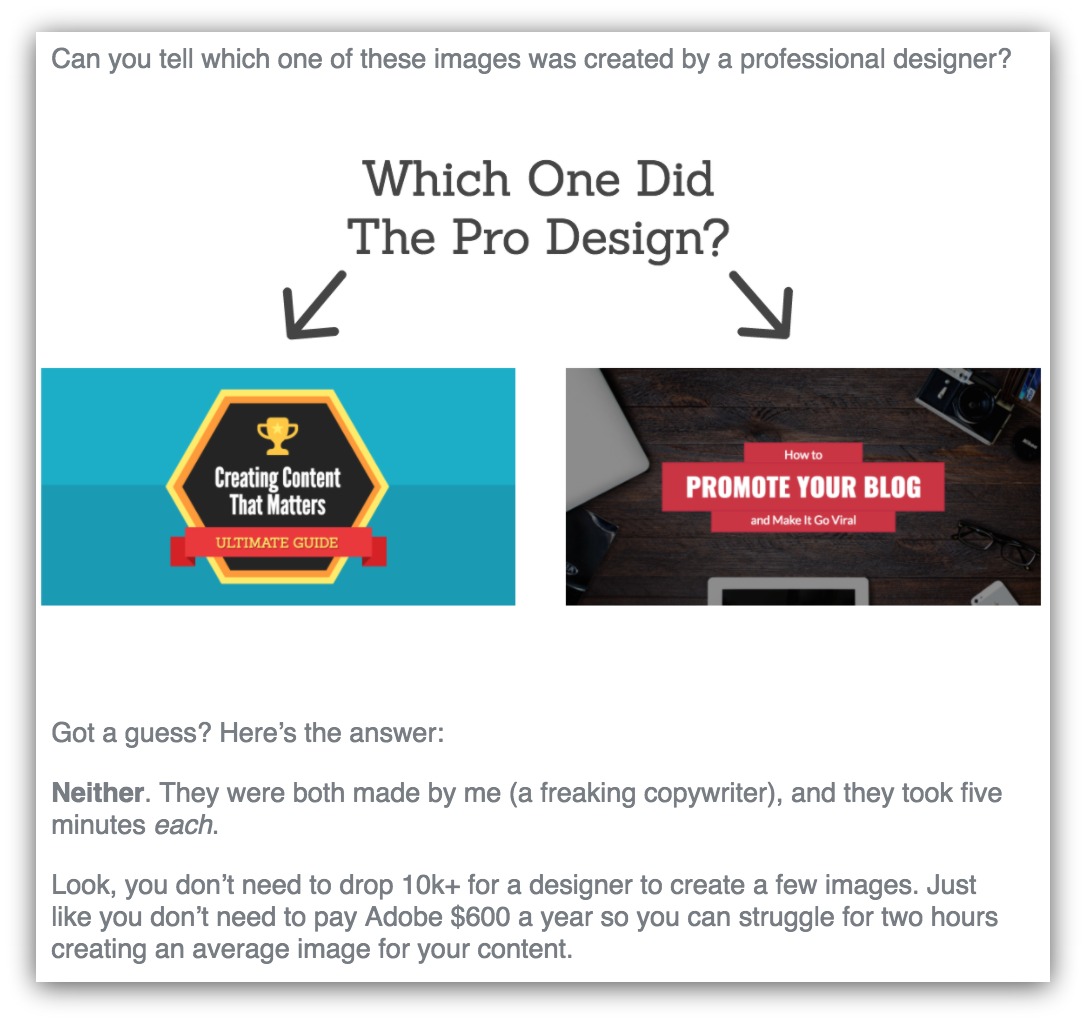
This hook is meant to be a quiz. Surely you could spot the difference between an amateur or professional image, right? That question brings you down to the image, which in turn brings you to the next line.
In contrast to the last example, this hook only lasts a few sentences. It’s a more direct approach, leading into the offer quicker.
But notice in both examples how each sentence builds off the last one. It’s like climbing a ladder — each new sentence is a rung, building off the previous rung and bringing you closer to your goal.
2. The Offer
Why is the offer the second element I list? Because it combats the single biggest mistake I see in emails (from rookies to pros alike).
When you write a medium-sized email, the temptation is to write this big J.K. Rowling narrative that makes your product sound like the second coming of Dinkytown Delight (a “fancy” beer from my college days).
Here’s the thing. The longer you go without mentioning your offer, the more likely readers will leave without acting.
That’s why I’m mentioning the offer as an early building block. Burying your offer below a wall of text means it’s that much harder for your reader to see what the heck you’re giving them.
Here’s why your offer almost always comes after the hook:
-
People are busy, cut to the chase: You get a ton of emails per day. Including your offer closer to the top of the email means your offer is seen by more (impatient) readers.
-
You built momentum: Readers will act if your hook is good enough or your offer is strong enough. No need to make the reader wait forever if they’re already interested.
-
You can strengthen value later: Leading up to the offer is a big tease. It’s better to say what you’re giving away and then mention the strong points — not the other way around.
The great thing is how easy it is to write your offer. It’s as straightforward as can be, really mirroring the approach you take in a short email:

This is the offer that followed the example I just showed. We say what to use, the price and how to get it. Nothing fancy, and it doesn’t have to be. You want to be clear and concise with your offer.

Here’s another email where the offer comes directly after the hook. This happens to be the entire email, btw. The offer is straightforward and easy to understand.
But ONE offer isn’t enough. If I gave you a basketball and told you to make a free throw, would you rather have one shot or 10 shots?
It just makes more sense to give your reader as many opportunities as possible to claim your offer. Each reader will respond differently to your email, meaning certain parts will make them want to act. You don’t want them to scroll around to find a link — you want it readily accessible.
Here’s an example from a highly successful email we just sent:
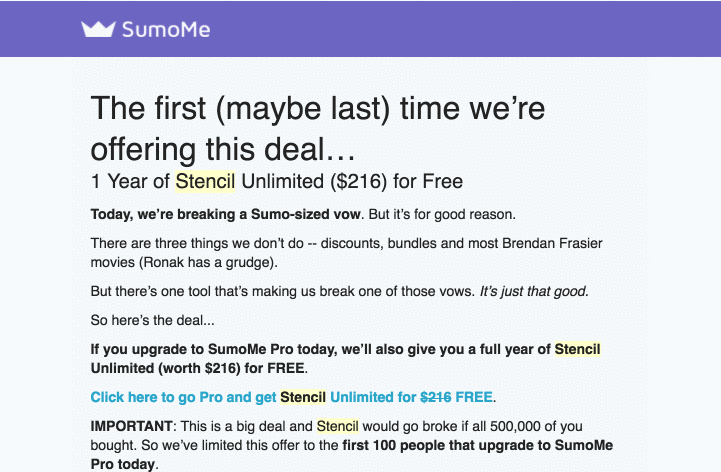
We include four opportunities to buy in the email. They’re all spaced out evenly after making claims or appeals. The multiple offers — as opposed to one offer at the end of the email — give you more opportunities to make the sale.
3. The Benefits
What would you rather have for your phone? A Snapdragon 820 processor with 4GB of RAM? Or a faster way to send messages, images and video to your friends and family?
You can actually have both because they’re one in the same. It’s just one of those is framed as a feature (what it is) and the other is framed as a benefit (what it does for you).
After you’ve written your hook and offer, you need to describe your offer and address the benefits. What are the details to your offer? Why would someone want your offer? How will it help them in their life?
Let’s go back to that Stencil example:
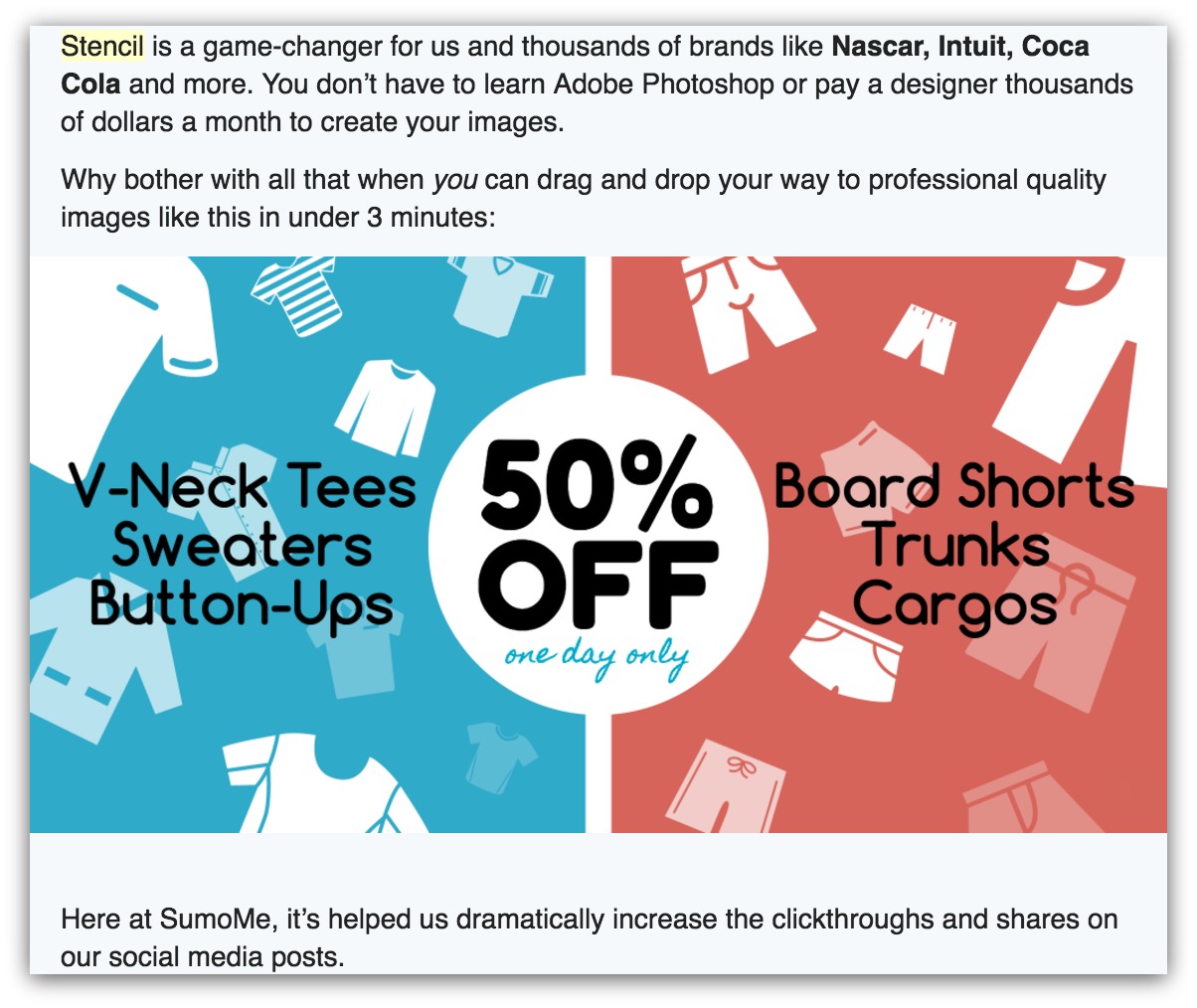
First, there’s a strong benefit in “You don’t have to learn Adobe Photoshop or pay a designer thousands of dollars a month to create your images.” The sentence has the benefit of saving time and money because, implicitly, this tool is easy to use.
Then look at the sentence before the image. The mistake would’ve been to say “Stencil has awesome drag and drop capabilities in their builder.” That’s just a feature.
Instead, it’s turned into a benefit by showing what drag and drop can do in a small amount of time (three minutes). That’s the true benefit of the drag and drop.
Or, take the common mistake of listing out features. It’s great if your car has “heated leather seats, satellite radio, 350 horsepower” and whatever else. But what does that do for the person who would buy the car?
Here’s an email where those common features are backed up with explicit benefits:
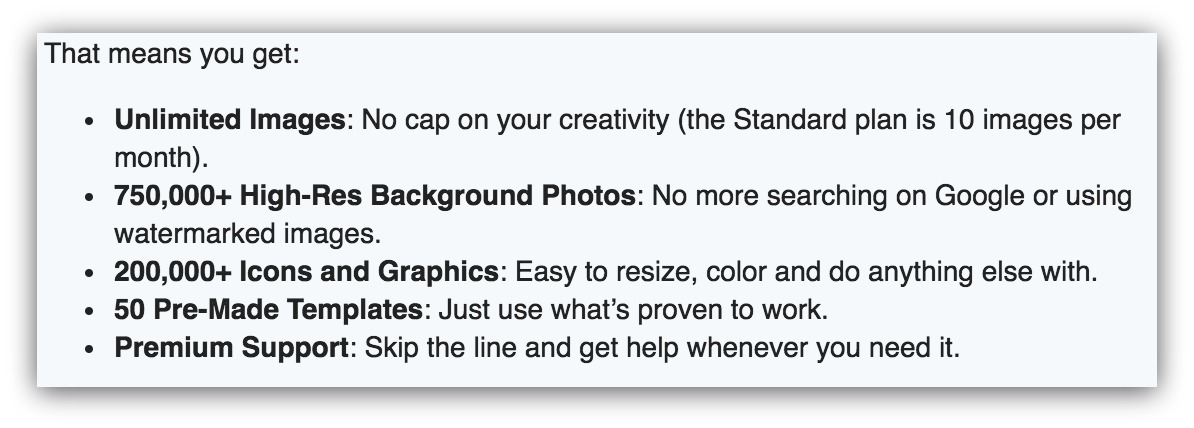
“No cap on creativity.” “Stop searching on Google.” “Use what’s proven to work.” Every feature has a tangible benefit. Every time you want to talk about the features of your offer, make sure you either switch it to a benefit OR back it up with benefits.
4. The Appeals
I was going to make an analogy between this last building block and the food pyramid, but my editor told me the food pyramid was replaced with some weird plate thing.
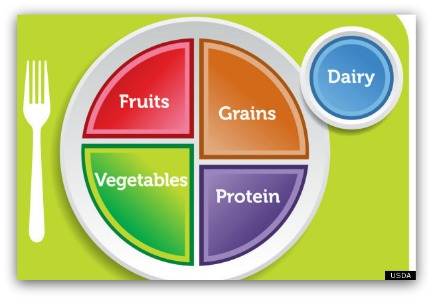
Who did this? I want names.
So that’s out the window. Here’s what you need to know about appeals in emails: they are the small, subtle touches that subtly but dramatically sway your reader to buy.
These are sprinkled in at a high rate through emails of this length. And you’ve got a lot of different appeals to choose from. Here are some of the most-utilized in sales emails…
Social proof. This is when you show either big names or the amount of people that have claimed your offer or use your product/service. This accomplishes two things:
-
Prove that people love the offer and that it has value
-
Make the reader feel like they should be part of that group
This works best when you have a large number or big brands:

Nascar, Intuit and Coca Cola are pretty big brands. Those names alone can prove your offer’s worth.
Results-based proof. Want to prove your offer is valuable? Show that it actually worked for someone. If you have numbers, images or proof that your offer works, show it:

This example shows the advantage of using a product vs. not using it. Can’t argue with results, which puts the reader at ease to know they’re buying something that works.
Testimonials. The close cousin of the results-based proof. You can write til you’re blue in the face (or fingers, for my northern peeps), but letting your reader hear from someone like them holds more sway than you saying your offer is great:

This example is from Brian Dean as he promotes YoRocket. He could talk about the product working, but having Sean, Chris and David say specifically how it helped them is instantly more relatable to the reader.
Urgency appeal. Most people think of time as the sole urgency appeal. You’ve heard it before…”24 hours left before ____.” But that tactic is usually used in recap emails when time is an issue.
The urgency I’M talking about focuses on quantity. “Only X spots left,” “Only X available,” and “Limited quantity” are the usual suspects:

Readers rush to buy when there’s a limited quantity of something. They don’t want to miss out on owning or being part of something unique, so this specific appeal causes a quicker impulse to buy than other appeals.
Value through selectiveness appeal. This is a sneaky and hard to pull off tactic, but man do I love it. This is when you put up a perceived or real barrier to your offer. Generally this means you’re very selective of who you allow access to — much like college admissions (learned this the hard way…thanks, University of Minnesota).
This selectiveness gives your offer more value. If few can claim the offer then it must be quality, right?

Ramit Sethi sent an email like this to his readers, demonstrating that he doesn’t let just anyone buy his course. The goal is to make you realize:He doesn’t accept everyone → He loses money because of that → If he’s ok with that then the offer must be quality → You want that quality.
Gut check appeal. This is the last appeal I see used frequently, and boy is crafty. It’s one of the strongest emotional appeals available because it asks a question that makes you want to be a better person:

They usually look like this. When you read it, of course you want to do something about it — not doing so would imply you’re lazy and don’t want to do what you love. And the assumption is, within the context of the email, your offer would help that person achieve what they want.
You have to be careful with this appeal, though. If you straight-up say, “Wow I guess only losers wouldn’t buy my product” then you’re just going to come off looking like an ass. These kinds of appeals usually come at the end of a long email full of narrative that made the reader visualize a better life.
Example: Stencil Unlimited Offer Email
Ok. That was a lot of individual parts. Kinda feels like a “trees for the forest” scenario.
But now you know all the parts to an medium initial email, which means you’ll appreciate this next part even more. Let me show you a real medium initial email and break down each individual section.
We’ll use the email we’ve alluded to the most: the Stencil email we wrote for Sumo. Here’s the first part of it:

1. Here’s our hook. It frames the offer as something we haven’t done before, which gives an air of mystery and intrigue because we’re breaking our normal business practice for this deal.
2. Here’s the offer. We plainly say what it is and we give a link to buy. The offer is here because we build it up in the hook and want to resolve the curiosity.
3. An urgency appeal. The offer already has some prestige to it now, on top of the strength of the offer in general. Adding an urgency appeal here immediately promotes a sense of urgency AND builds on our promise in the hook that this offer is too good to last.
4. We describe the offer and throw in some social proof. This is the beginning of actually selling the offer on its own merits. The social proof shows that big companies already trust this product (so the reader should, too). Plus, we add a line of benefit to relate to the reader.

5. Results as proof. Instead of describing the offer in detail, we show the benefits by making a claim and backing it up with an accompanying image.
6. More results as proof. Now we’re starting to lay the proof on thick. We show what kind of results the offer gave us, and the reader starts to realize the kind of results this offer brings.
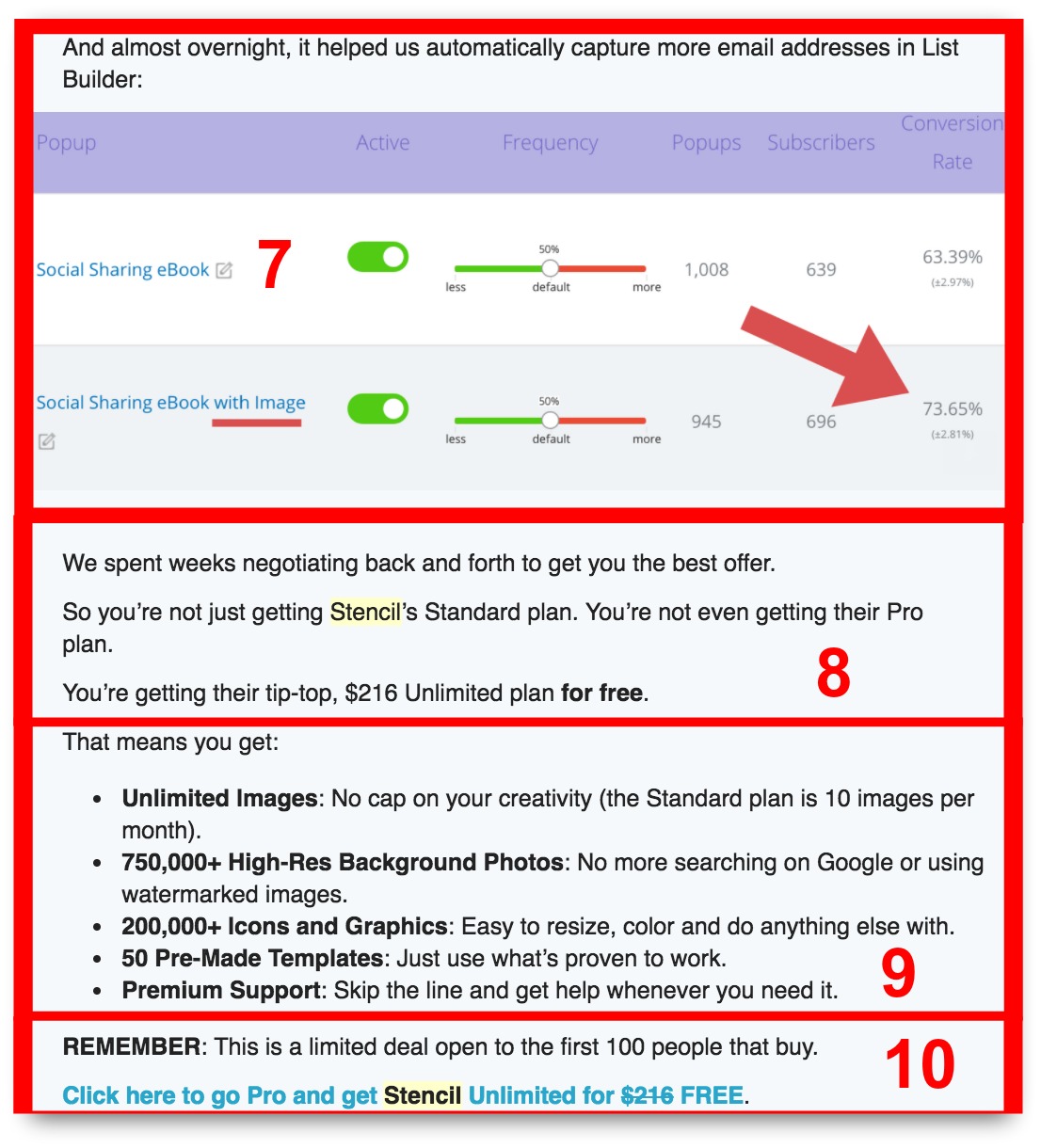
7. Even more results as proof. This is the last bit of results we use to drive home the value of the offer. With three of these in a row, there’s no doubt in the reader’s mind that this offer can deliver.
8. Strength of offer. Giving a glimpse behind the curtain helps the reader see how rare of a deal they’re getting. The offer only gets stronger with this area as we take the time to show how much of our time went into making this happen.
9. Benefits and features. We gave enough results, so we need to say what else this offer come with. But, since spouting features is a no-no, we back each feature up with a benefit to make it relatable to real-life problems.
10. Urgency and repeat the offer. By this point we’ve shown a lot of results and benefits, so the reader should feel compelled to buy. Instead of simply giving another link to buy, we remind the reader of the urgency by repeating the limited nature of this offer.

11. Benefits and features (Sumo remix). Since our offer includes buying Sumo, we take the same approach as before and use the feature/benefit technique. However, since the focus of the offer is on Stencil and our list knows what Sumo is, we only dedicate a small portion of the email to us.
12. One last offer with urgency. It’s the end of the email and it’s time for the hard sell. If the reader made it this far down then they should be close to buying. We mention the limited quantities once more since urgency is one of the strongest motivators around.
And that’s the medium initial sales email in action:
-
There’s an enticing hook to build intrigue and curiosity.
-
We answer the curiosity by revealing the offer and setting the tone with urgency.
-
We build value through a ton of positive results.
-
We describe the value of the offer through benefits.
-
We repeat that with the second part of the offer to add even more value.
-
We close with more urgency to prompt purchases.
Obviously your email can differ from ours — hundreds of thousands do. But you can see how using the four building blocks I outlined can create such a complex email.
It’s like jazz music. Everyone works with the same notes, but the final product is always something unique.
The Medium Recap Email: Crank The FOMO Up To 11!
I realize FOMO might seem like something that the youths say…

But it’s a legitimate marketing term that will define the medium recap email more than you think. FOMO stands for Fear Of Missing Out, and this kind of email is geared towards making the reader feel like they’d miss out big time if they don’t claim your offer.
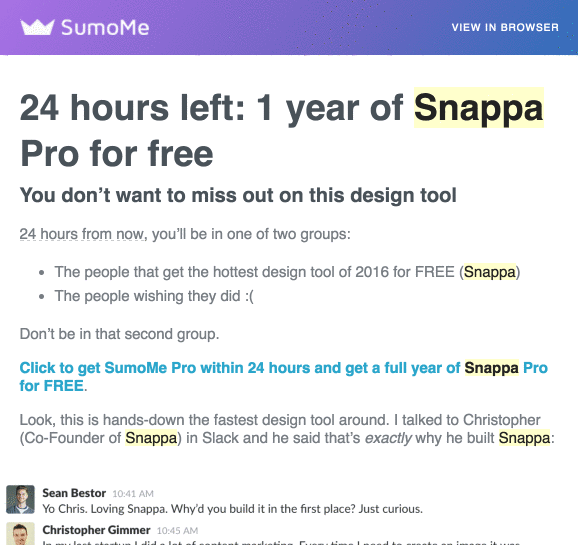
But be warned. If your medium initial email fails, then this could be the hardest email you’ve ever written.
Pros of the Medium Recap Email
-
Create A Fear of Missing Out: No, this doesn’t mean being spooky and typing in all italics like Dracula’s voice. You create this “fear” by emphasizing the finality of the offer. Replicate this fear and you’ll sell a lot.
-
More Areas to Create Urgency: Recap emails live through urgency. Medium recap emails have a lot more opportunity to include multiple appeals to urgency.
-
More Space to Sell: In short recap emails, you don’t have a lot of room to convince the initial non-buyers to buy. With a medium recap email, you do.
Cons of the Medium Recap Email
-
Takes Time to Write: Just like the medium initial email, this is a 50-500 word email. They take a while to write — especially if you’re just starting out. If you’re crunched on time this won’t be the email you’ll want.
-
Must Be Flexible: You have to monitor your initial email closely. If it sells close to what you expect then you’re in great shape. If it doesn’t, you have to pivot and write a new email. Speaking of…
-
Essentially Writing A Second, New Email: If your initial email doesn’t sell a lot then you have to write a completely new email without repeating a lot from the previous email (because why would you repeat what didn’t work?). And, assumedly, since you used your “A” material in the first email, you’re stuck picking from what’s left in your offer.
The Anatomy of A Medium Recap Email
This might seem like the laziest description ever, but it’s 100% true.
If your medium initial email sold a lot, then you don’t have to change a thing for the recap email.
I’m dead serious. You can literally keep what you wrote in the initial email, update the urgency to reflect the current status (X hours/quantity left) and send it to people that didn’t open or buy initially. We’ve done that and it’s worked well. Or you can send a short recap email because you don’t need to explain a lot.
But that’s not what we’re talking about in this section. If things went well, you can sit on your pile of money and laugh at the rest of us. Because, odds are, your initial email might not go according to plan, and you’ll need to send a recap email to recoup sales.
When that happens, the medium recap email will be your best friend and worst enemy:
-
Best friend because you have more room to sell the non-buyers.
-
Worst enemy because you have serious rewrites to do.
Here are the big changes in the recap email:
1. Ditch the Description
You already gave a general overview of your offer. If people didn’t buy then why in the world would you repeat that overview?
The reader knows what your offer is about if they saw the first email. They know what your product or service does. That’s not why they didn’t buy. They didn’t buy because they didn’t see the benefit. Your benefit won’t come from describing the product or service more.
So it only makes sense to cut that area and use it to say something else. You instantly get more space to write and you don’t bore the reader by repeating what you already said.
Take this initial Snappa email we sent:
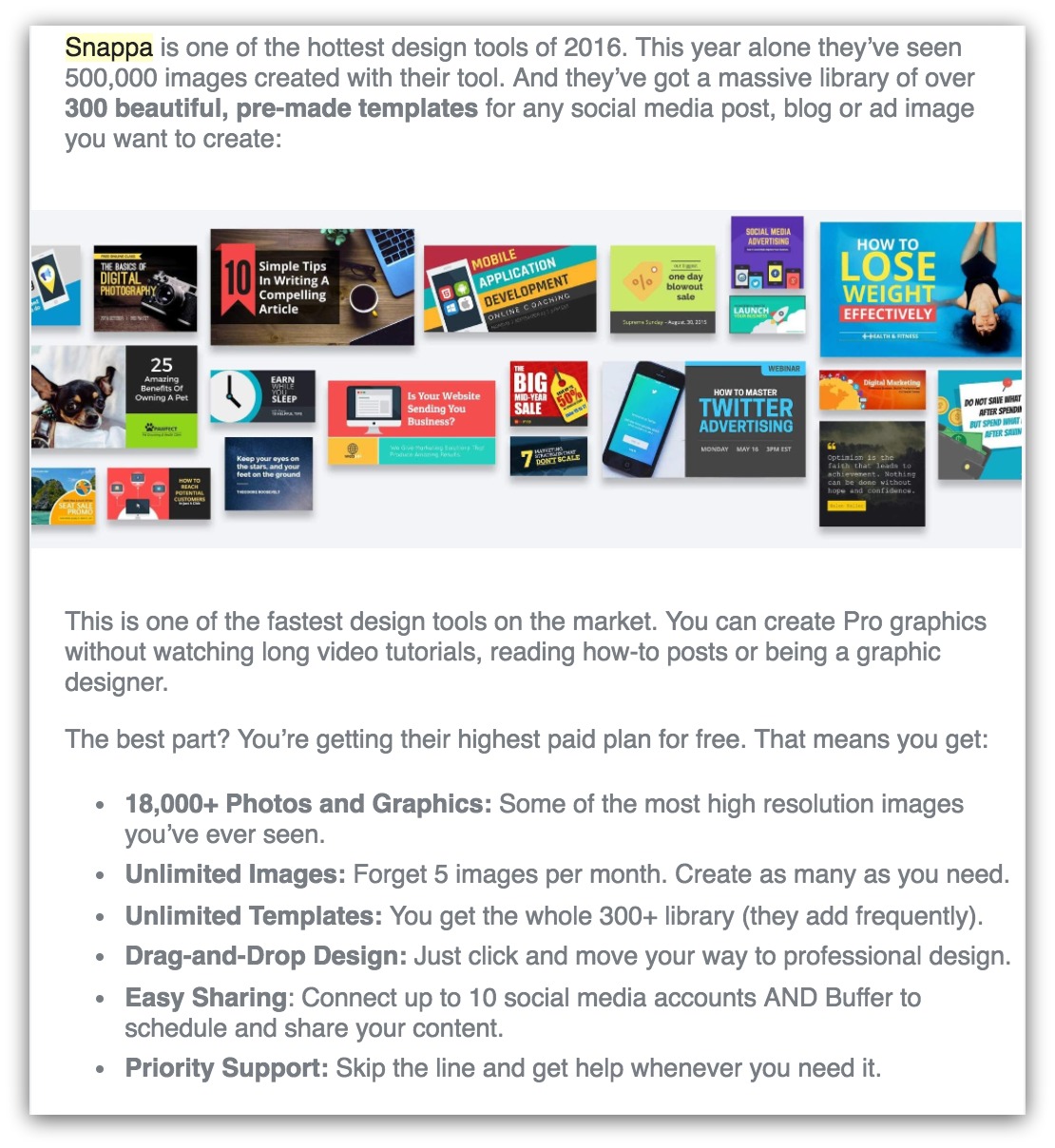
It’s a lot of us explaining what Snappa is. Our readers may not have known what Snappa was, so we took the time to explain the offer while also mixing in benefits and appeals.
But on a recap email? They know what Snappa is. So it wouldn’t make sense restating all the things we said in this email. It wouldn’t resonate and it’d be a waste of 130 words.
Instead, you ditch that description and do the next thing in this list…
2. Find New Angles
I’m not gonna lie to you. This is the hardest area of a medium recap email.
I know how it goes. When you write your initial email, you include your best stuff. You spend a lot of time on it because it’s supposed to be the email that breaks the bank.
So if things don’t go according to plan, it can feel impossible and demoralizing to come up with new angles. But what’s the alternative? Sending out the same email that already didn’t work?

You can’t NOT hear the voice
The livelihood of your offer depends on how you reposition things in this email. And since it’s a bit hard to explain, I’ll show you an example first and then work backwards.
I’ll work from the Snappa email so you can see a before and after approach. Remember, this was the “Before” in the initial email:
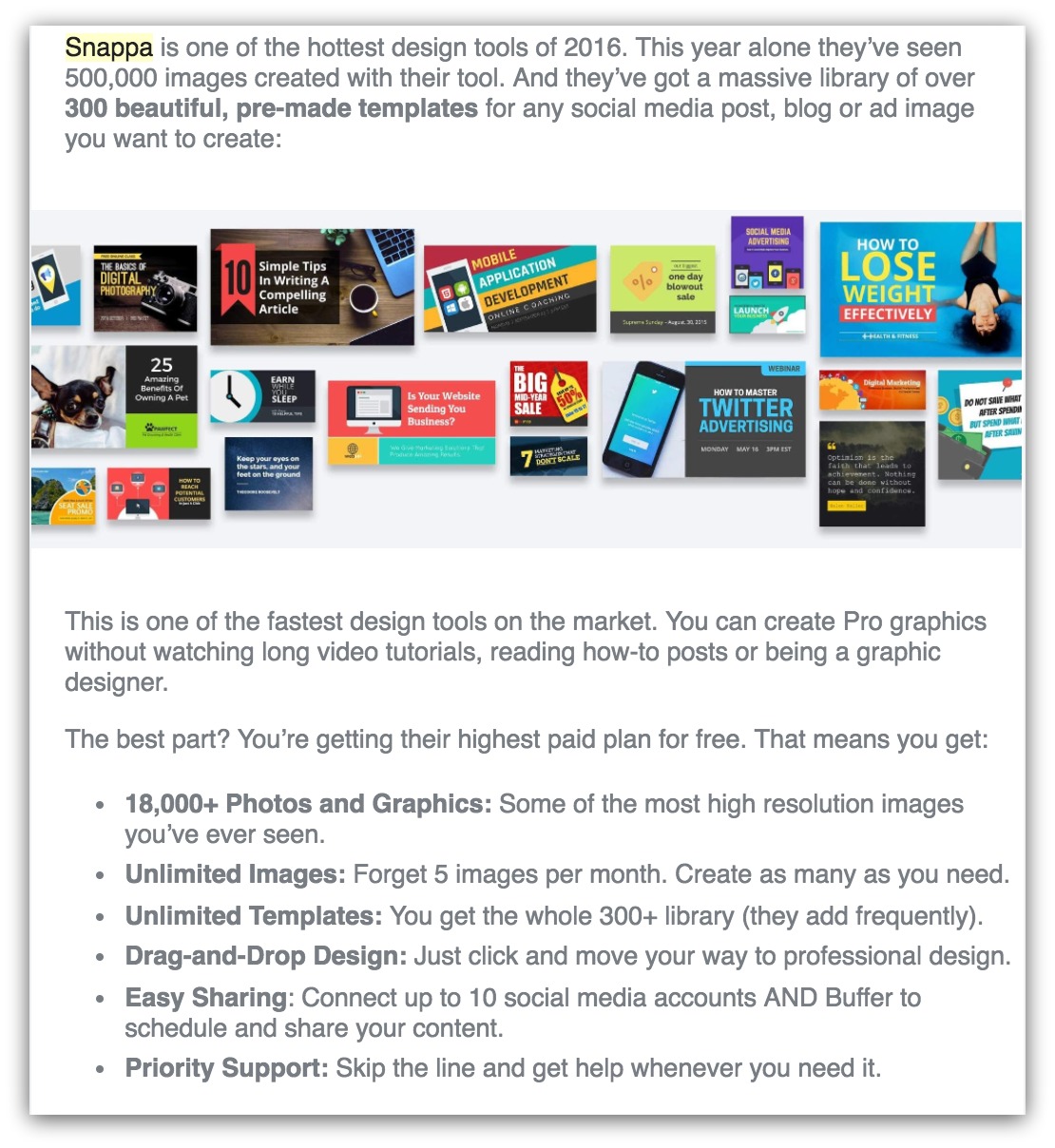
And this is the “After” in the recap email:
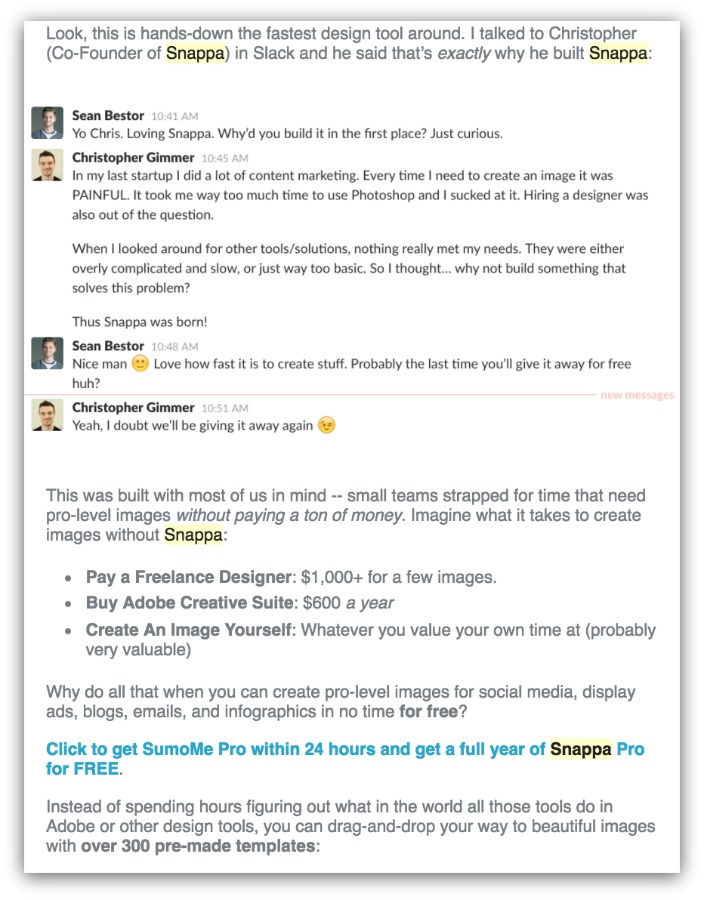
It’s a complete pivot from talking solely about what the product does. This new angle shifts from the product and focuses more on the human element of:
-
Why the founder created Snappa (solving problems)
-
What happens if you don’t have Snappa (lose money, limited inventory)
-
New features/benefits we didn’t talk about before (pre-made templates)
This more relatable approach only works because we laid the groundwork of describing the offer in the initial email. Sending this recap email first would’ve been confusing as hell for readers because they might not have known what Snappa was.
When you absolutely need to find a new angle for your email, think of these three tips:
-
Mention new features: Are there any other aspects to your offer you didn’t mention? Find those and speak to them, because what seems small to you could mean the world to your readers.
-
Zero in on previously mentioned features: Those big key features you mentioned in your initial email? Find your best one, put it under a magnifying glass and give some new in-depth benefits. If you have something that clearly stands out and solves a need then strip down everything else and blow that aspect up.
-
More appeals. I SAID MORE APPEALS!: The appeals I talked about in the initial medium email section? Bring ‘em out, and bring lots of them. You’ve already talked about the logical aspect of your offer. Now you need some emotion. Think of Amazon. Sometimes it’s the reviews that seal the deal for you. Replicate that with testimonials, results and more.
Once you’ve got your new angle, you need to evoke one of those “Oh crap, I need to claim this offer right now” feelings.
And there’s nothing better for that than…
3. Use More Urgency Appeals
When was the last time you heard someone yell “FIRE” and everyone said, “Eh, I’ll get around to exiting the building tomorrow or something.”
Exactly. I’m not saying your email has to set someone’s computer on fire, but it should make them want to act on your offer ASAP.
How? Urgency.
Since this is a recap email, we don’t have to rely on just quantity-based urgency:

We can tap into the time-based urgency, too:

You need to make it very clear that your offer is going away soon. Mentioning it in the email multiple times won’t hurt, either. You can even write more of a narrative around the urgency like James Altucher does:

Remember, anything under 24 hours is acceptable. Anything longer than that and no one will act because it isn’t urgent enough. We once sent a recap email with a 48 hour end point. We….don’t speak of that email in public.
There really is no bad place for urgency in a recap email. Start the email off with it, include it in the middle, throw it in the P.S…it’s up to you how often you want to use urgency without sounding like a used car salesman.
The point is, the more urgent you make your offer feel, the most likely your reader is to buy from that email.
4. Create A Little Pain
Easy, now. I see you furrowing your brows over there. “Who is this sadist urging us to make our readers feel pain?”
Look. Don’t go tapping into repressed emotions or daddy issues or anything like that. Pain, in this sense, is just the perceived regret of missing out on your offer. Or, bringing things full circle, feeling FOMO.
You create this feeling by staking an overwhelming sense of benefit against the consequences of missing out on that benefit.
There are three levels to creating this pain. The first is more subtle:

Hey, this is as subtle as it gets. It’s James Altucher again, and he’s saying he can help you make money BUT if you don’t take his offer you’ll be one of those investors that makes mistakes and loses. The “huge mistake” line is just a guess, more used for curiosity than anything.
The second level is a bit less subtle:
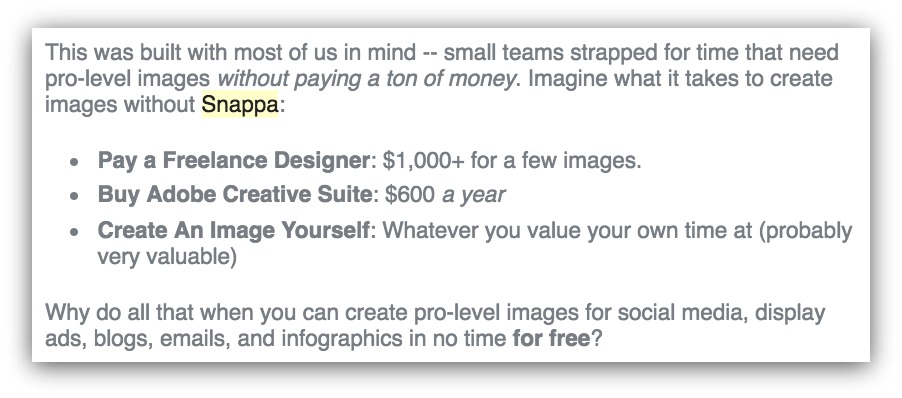
This one calls out specific prices the reader would pay and aks how valuable their time really is. If you miss the deal, you admit you’re ok with paying extra money and devaluing your time. No one wants to admit that.
Then there’s the last level, which is about as subtle as someone with a megaphone yelling in your face:

This line cuts through the subtlety and addresses the reader directly. You can either claim the offer and do what you love, or you can just dream and talk about it. It’s a real gut-check and gets to you at a personal level.
But notice how it’s still not intensely negative. It’s only negative if you don’t claim the offer. It doesn’t shame you or say “You’re a loser if you don’t claim this deal.” It just presents the offer and frames the consequences if you don’t purchase.
These medium recap emails are no joke. They take time and skill to pull off. HOWEVER, heeding these changes puts you miles ahead of marketers that send a recap email to its grave because it copies the initial email that (may have) flopped.
And that brings us to our last (and biggest) sales email of them all…
The Long Initial Email: I Hope You’re An Elite Writer
In my 10+ years of writing sales emails, I’ve written a long initial email…
Three times. That’s it.
Why? Because they’re extremely difficult to pull off and take a lot of time to write. Plus, with the increase in emails sent year over year, a 3,000 word email isn’t exactly welcome in your inbox. Think of all the Netflix you could watch in that time.
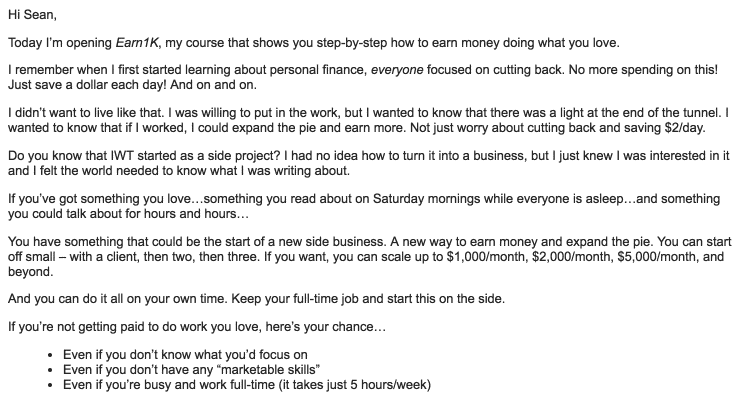
With all that said, let me make one other thing clear. If you CAN pull this type of email off, you’ll be (to quote a recent spam email) “…rich beyond your wildest dreams.”
Pros of the Long Initial Email
-
Did They Read Everything? They Probably Bought: A long email is like a story. It takes talent to hold interest over thousands of words. If a reader reaches the end of your ridiculously long email, it means literally everything resonated with them and they’re highly interested in your offer.
-
Great For Large/Expensive Offers: Obviously you can’t sell a $5,000 product in 40 words (unless you’re a hypnotist). Bigger purchases require more thought, and a long email can address every single objection or concern possible. Also, not a lot of people will purchase from a long email, but that’s ok. A high price means only a few people need to act.
-
Lots of Room to Sell: More words = more opportunity. Moving on.
Cons of the Long Initial Email
-
Extremely Difficult to Write: This is like a medium email on steroids. If you can’t hold attention for 100 words then it’ll be impossible to hold attention for 1,000 words. You have to string together the right sales pieces consistently without missing a beat.
-
Takes Insane Amount of Time to Write: Comparing a 1,000 word blog post to a 1,000+ word email is like comparing apples to UFOs. Emails take a longer time to write because every sentence has to have a sales purpose. Expect to take a couple days even if you’re a seasoned writer.
-
Most Readers Won’t Read Everything: That’s the inherent nature of an email this length. Attention spans dwindle and people are busy. Expecting them to read your long email is equivalent to standing in line at the DMV. Most people will see the length of your email and immediately leave.
The Anatomy of A Long Initial Email
Dan Kennedy — one of the best long-form email writers ever — dedicated 240 pages to just one long template.
I…uh…won’t be doing that. That’d be pretty ballsy to even claim as much. The fact of the matter is, emails over 2,000 words are just too varied to break down in one article.
But I WILL share something even he failed to mention in his book. There’s one truth when it comes to long emails (initial and recap):
Long emails are just medium emails with longer sections and more appeals.
Yes, I know you can get technical and start breaking down each email bit by bit. Yes, I know you can create a completely new email by flipping a few sections to create an entirely new tone. Yes, there are deep intricacies that lead a man like Dan Kennedy to write an entire book on the subject.
I get all that. But by and large, if you can write a great medium email, you’ve got what it takes to write a long email.
I’ll show you why. Let me break down one of Ramit Sethi’s long initial emails (1,300 words). Ramit is one of the best long-form email crafters around, and his emails are usually 800-1,500 words in length. That’s an attainable range to shoot for, and his emails are proven to work at that length.
As you read this breakdown, notice how similar it is to the medium initial email. The only thing that differs is how many words Ramit dedicates to each area.
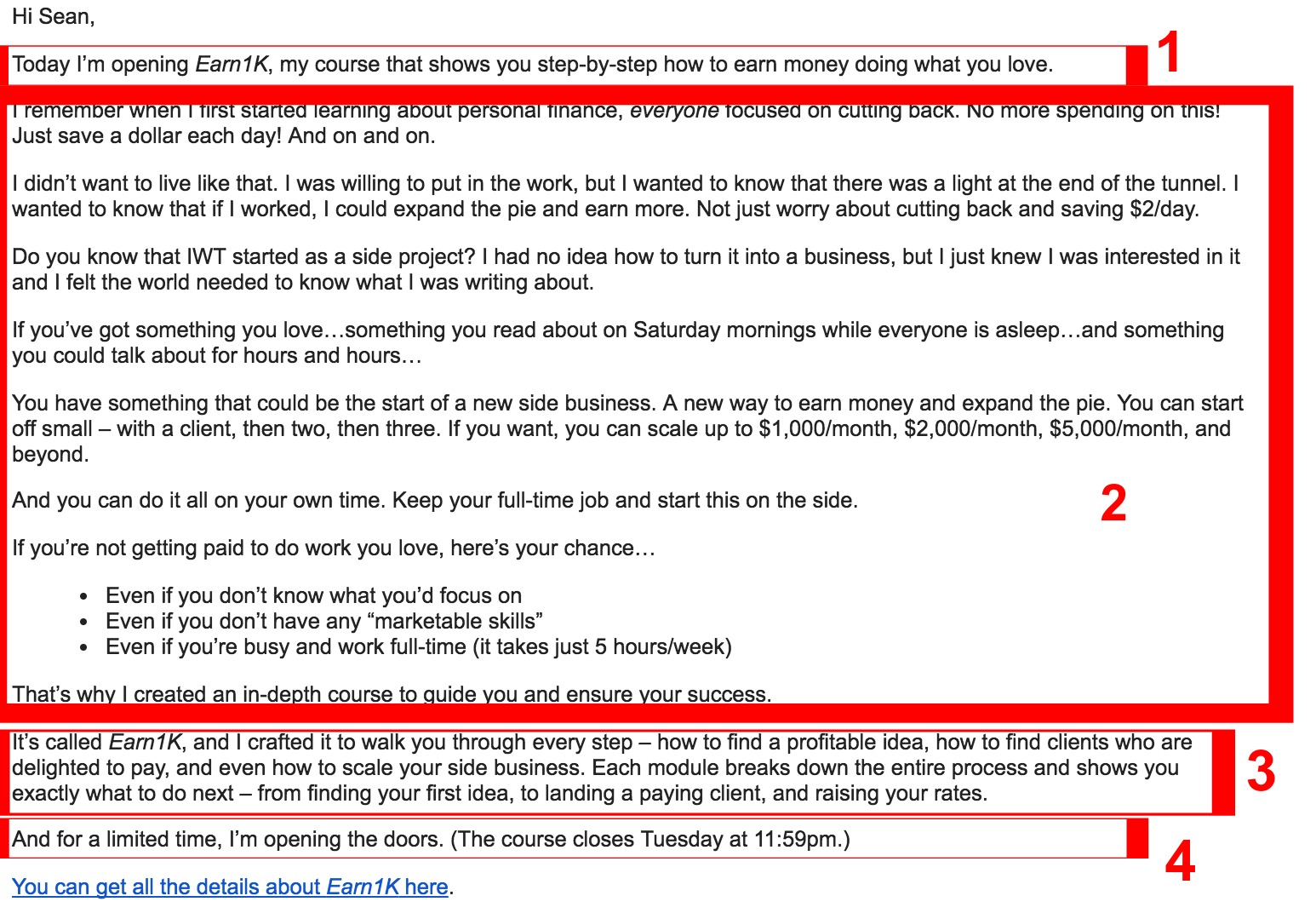
1. The offer. Ramit tells you what he’s offering right away. He doesn’t link to it, though, because he wants you to read more about it.
2. The hook. This is effectively where his opening starts. Ramit is empathizing with the reader, talking about his humble beginnings. He transitions that into visualization, making the reader visualize a better life. It’s an appeal that associates what you want with what he can provide.
3. The description. Here he gives a brief, high-level description of his product.
4. Urgency appeal. He gives a deadline to buy. This forces the reader to make a quicker decision.
So far, nothing is different from a medium email — just the length of each section. Let’s move on to the next part of his email:
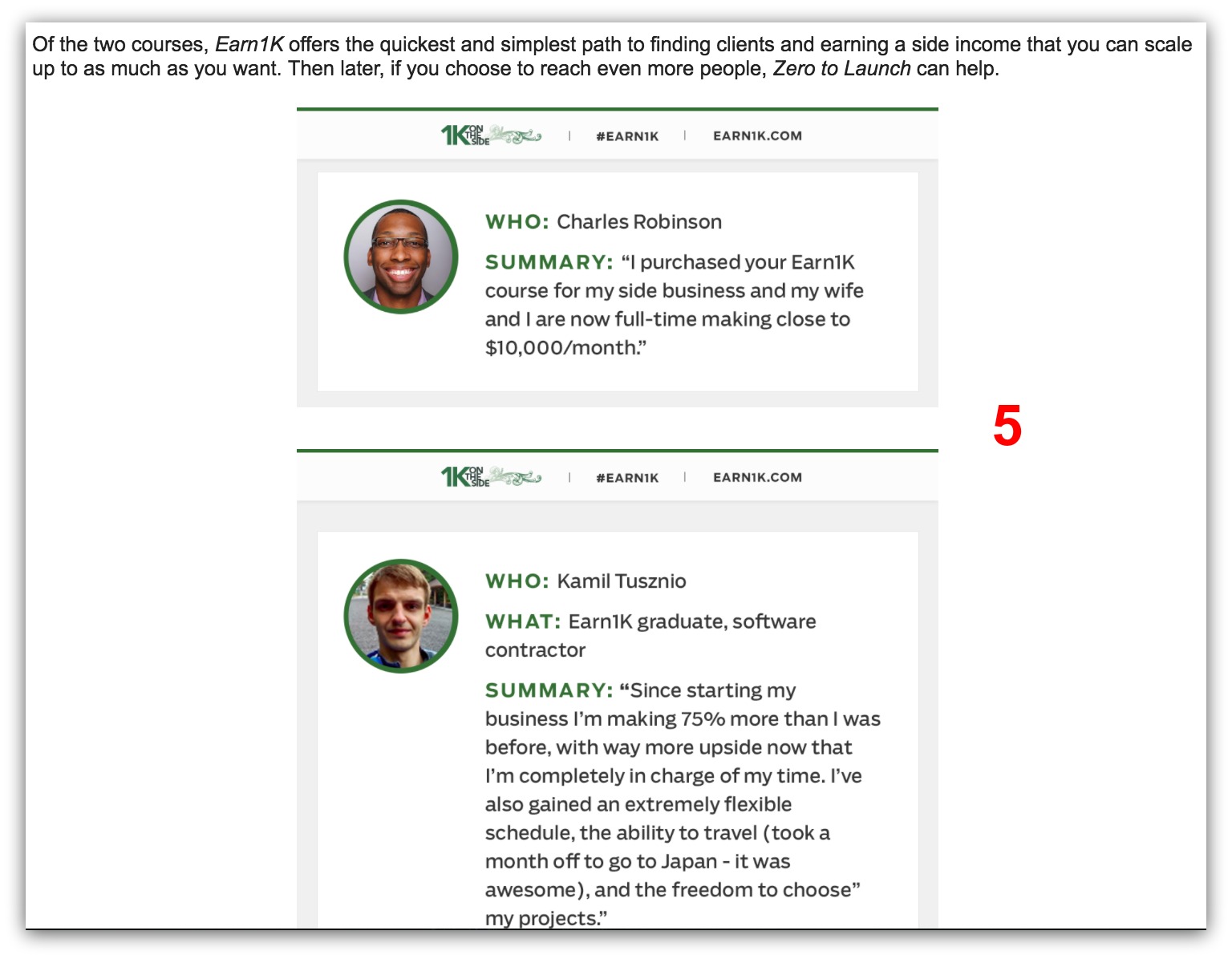
5. Testimonials. Here’s another appeal, and it comes pretty early. He hasn’t gone in-depth into what his product is, so he’s really trying to build up an early emotional response. Plus, using testimonials as images breaks up the monotony of text.

6. Benefits and features. Almost this entire chunk of the email goes in-depth to talk about what’s included in the offer and how it can help your business.
7. Addressing objections. This isn’t something I mentioned in the medium emails. It’s more suited for longer emails because you have the space to do so. Addressing objections is powerful because it A) shows you know your readers’ thoughts and B) disarms any reason why they wouldn’t buy.

8. Guarantees. This is another type of appeal reserved for longer emails. Guarantees are the cousin of addressing objections — instead of answering questions, the guarantee is a stronger way to silence any doubts. Ramit brings the heavy guarantees at the end because it’s the ultimate clincher. You should be sold before this, but the guarantees add another layer of mental security, leaving no doubt that you should buy.
9. FAQ and the last offer. Really, you could take or leave the FAQ part. It’s not necessary, just something that Ramit can dedicate resources to. He ends the email with the offer and a small emotional appeal.
All in all, this looked eerily familiar to a medium initial email, didn’t it? Save for one or two things, the email had all the same elements as a medium email.
But it definitely feels more robust than those medium emails. You walk away feeling like you know more about the offer. That’s what a great long email will do — cover everything but in a more robust way.
Unsurprisingly, the next (and last) email echos another email structure we’ve already covered…
The Long Recap Email: The Last (Long) Chance to Sell
Surprise surprise. The long recap email is extremely similar to the medium recap email. Almost all the components of the original initial email are there, except there’s a new angle, more of a push for urgency and FOMO.
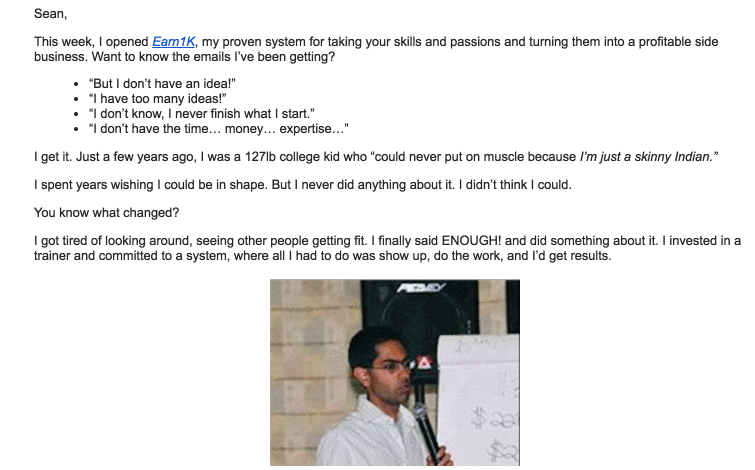
1,500 words. Woof.
Let’s get to it.
Pros of the Long Recap Email
-
Create An Even Bigger Fear of Missing Out: This email has to inspire real regret if the reader doesn’t take action. With an unlimited amount of words to do so, you can pull out every tool in your arsenal.
-
More Areas to Create Urgency: Recap emails live through urgency. Long recap emails have a ton of opportunity to include multiple appeals to urgency.
-
Did They Read Everything? They Probably Bought (Round 2): This is the last ditch effort, and it’s quite a long one. If your reader makes it through an email of this length filled with more urgency and emotional appeals then they’re as good as yours.
Cons of the Long Recap Email
-
Extremely Difficult to Write: Nothing changes here. Especially when you have to come up with a new(ish) angle. These are difficult emails to write, and the recap email is no exception.
-
Takes Insane Amount of Time to Write: On top of writing a lot of words, you’ve got the added chore of that pesky new angle. Those two factors combined lead to a long time staring at your computer.
-
Most Readers Won’t Read Everything: It’s still a long email. If they didn’t read your initial email, chances are they won’t read this one either. Length is a real barrier in a time-crunched world. Some people just won’t respond to a long email.
The Anatomy of A Long Recap Email
Like the long initial email, this email is a carbon-copy of the medium recap email — only longer. Certain elements are longer, there are more emotional appeals and the urgency is off the charts.
You already have a general idea of what the email will look like if you saw the medium recap email. So the best way to show the difference between the long initial and recap emails is to compare the recap email that follows Ramit’s initial email above.
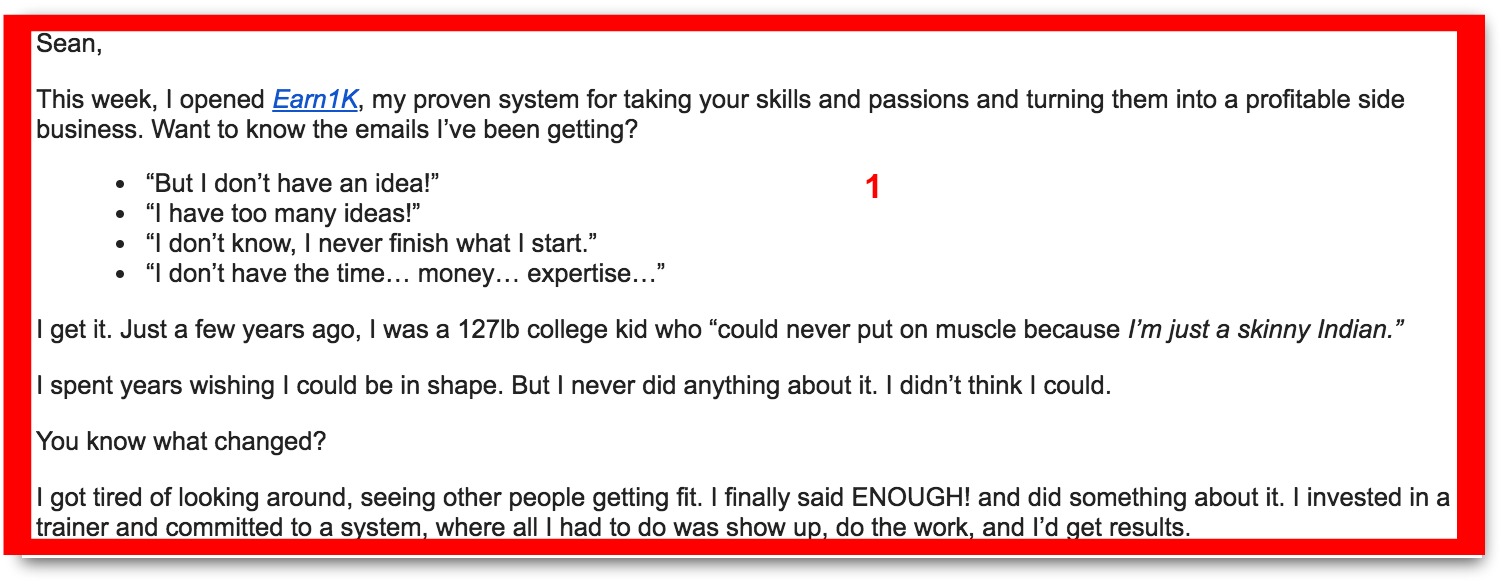
1. Offer and hook. Ramit sticks with the format of his initial email, directly talking about the offer in the first sentence and transitioning into the hook. The hook, though, is a lot more personal and emotional. He’s directly citing objections, which leads to a personal story. That story indirectly makes an “if I can do it, you can do it, too” claim. That motivates the reader to reject the objections Ramit lists in the beginning.

2. Results-based proof. Ramit shows two pictures (before and after-style) as proof he changed his lifestyle. These images strengthen that reader motivation, making them trust Ramit as someone who knows how to incite change.
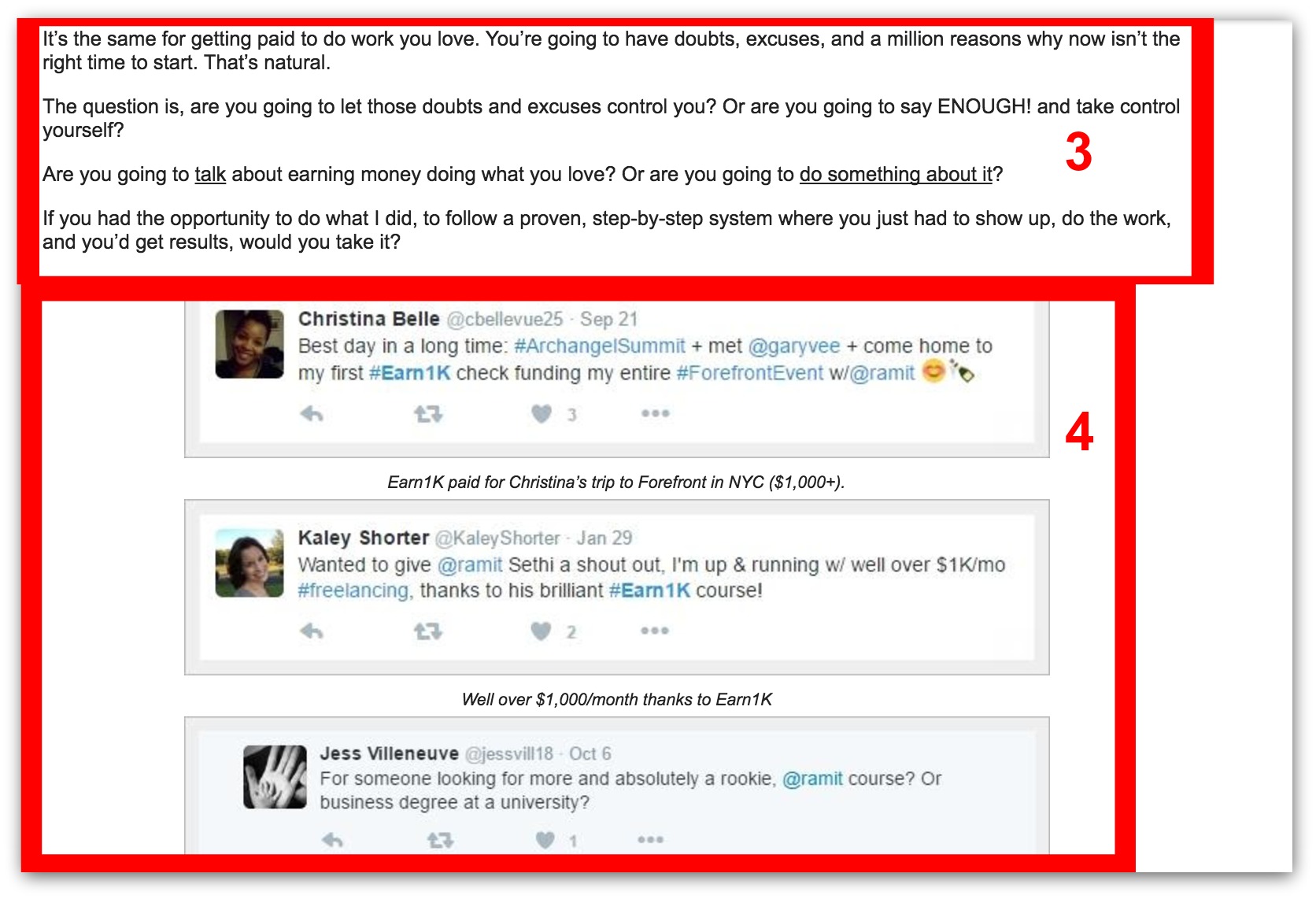
3. Fear of missing out and pain appeal. This is where the email mirrors less of the initial email and more of the medium recap email. Ramit is going straight emotional, asking the reader to take a serious gut check. It’s part visualization, too, because he’s making you visualize a better life and say “yes” to the results — a.k.a. what his offer promises.
4. Testimonials. To back up his results claims, he dives straight into testimonials from Twitter to show real people going out of their way to proclaim how great Ramit’s program is. If you make a claim of something working, it’s always a solid idea to back that up with proof — either numbers or testimonials. These Twitter testimonials actually continue for another screen grab or two, so I’ll spare you those images and jump to the next section.
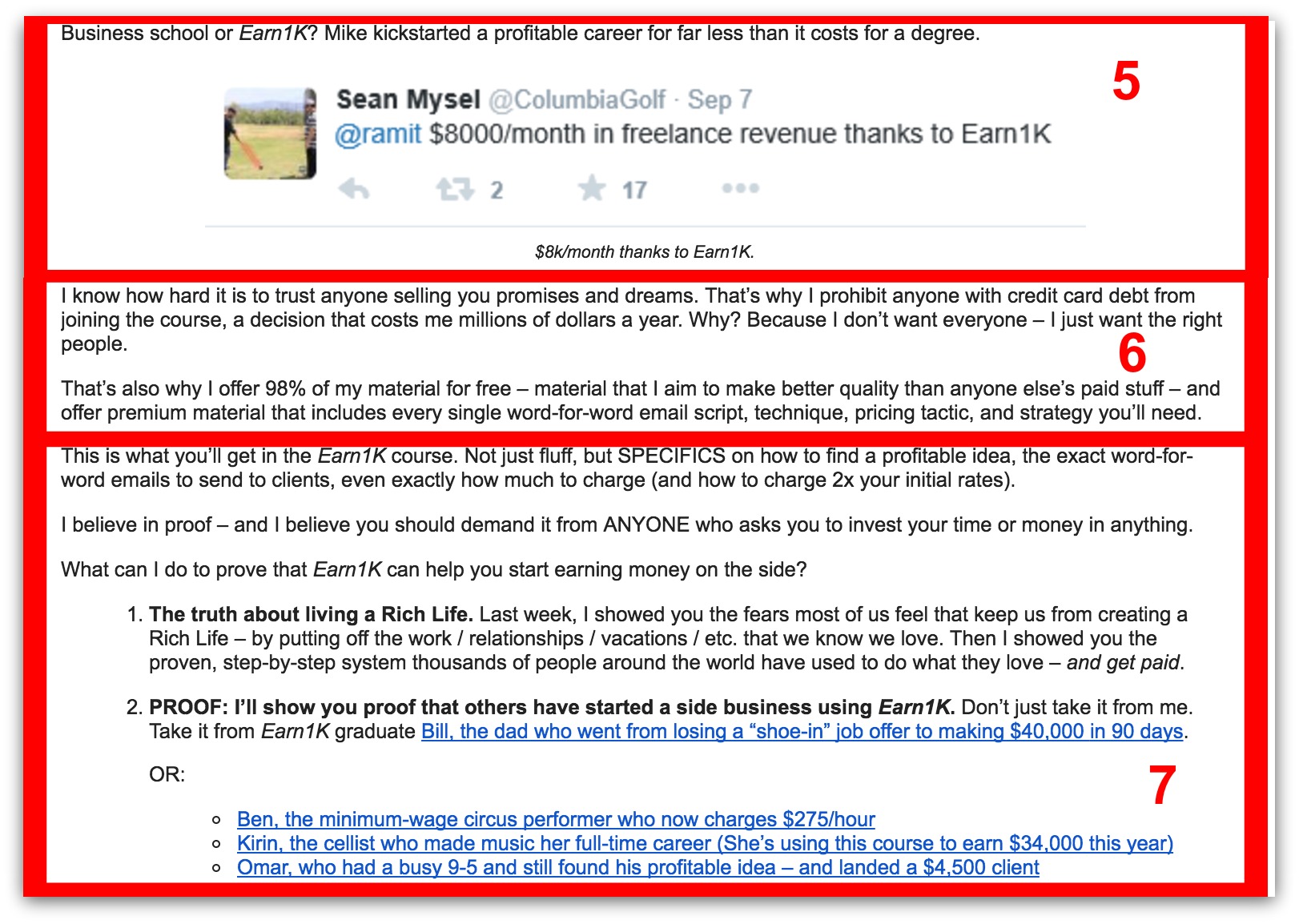
5. Value through exclusion. Ramit places some unspoken value on his offer by claiming he excludes certain people. That elevates the prestige of the product in the reader’s mind.
6. Features and benefits. Here come the product features/benefits. Yet, this time around, it’s a much shorter part of the email. That’s the nature of the recap email. The reader already knows what the product is. They don’t need to be sold on features and benefits. This is simply a transition into the next, stronger section.
7. Results-based proof. Here we see even more results from the product. Ramit really wants to show the reader the product works, so he’s pulling out every results-based proof possible.
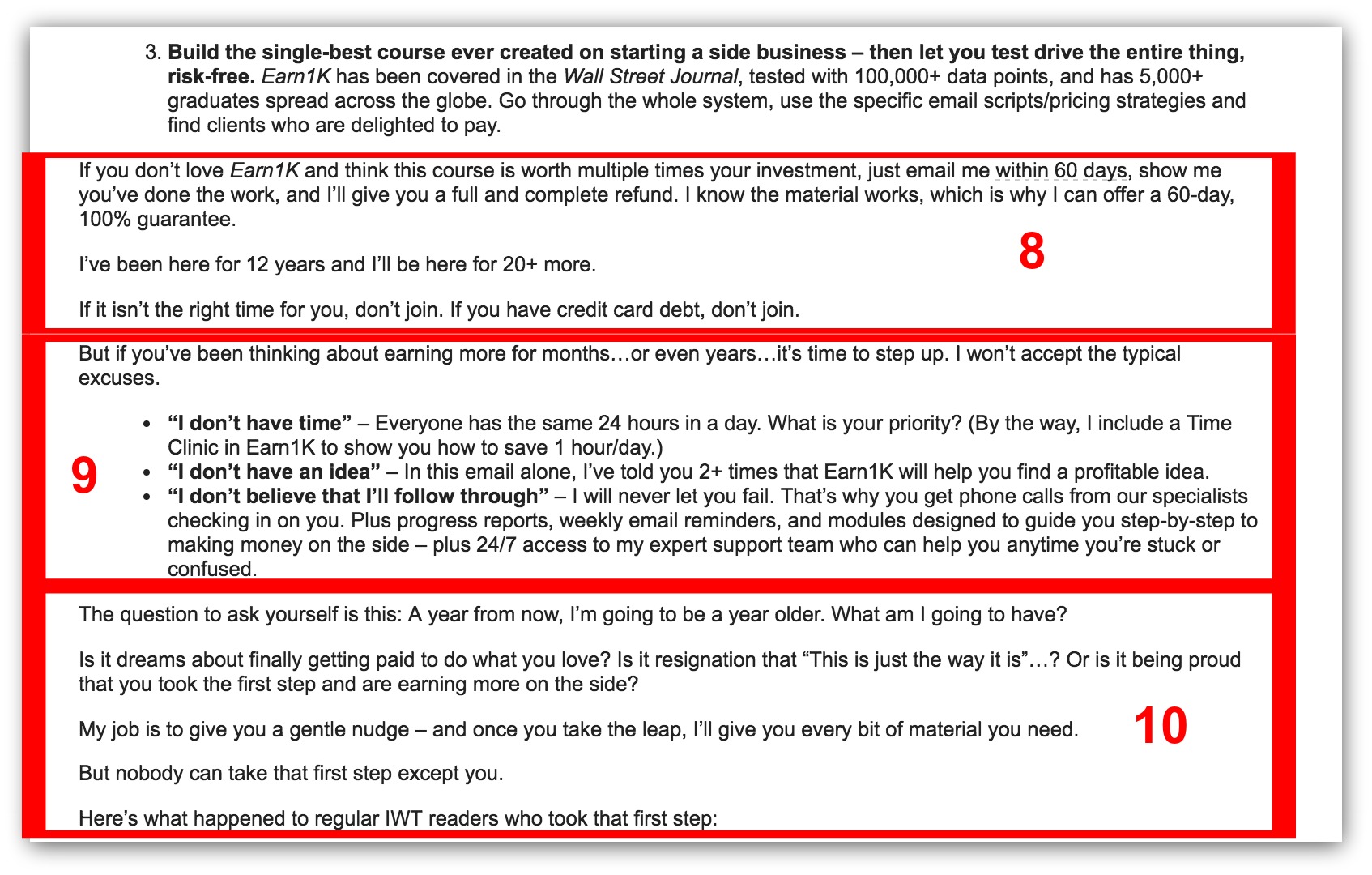
8. Guarantees. The inclusion of a guarantee in this spot is peculiar, as it could be placed almost anywhere. The best guess is Ramit thinks this is the spot where most people will be convinced to buy, as the last half of the email almost repeats the structure of the first half.
9. Addressing objections. Here’s where the email starts repeating in structure. Ramit goes back to addressing objections, this time listing more objections and specifically addressing each one. This is meant to stomp out the last of the reader’s objections after seeing all the reasons to buy.
10. Fear of missing out and pain appeals. Ramit goes hard on the FOMO. He’s asking what kind of person you want to be, framing it as doing what you do now OR living your dream (by purchasing his course). He brings out the gut check one more time, making you get real with your ideal self.
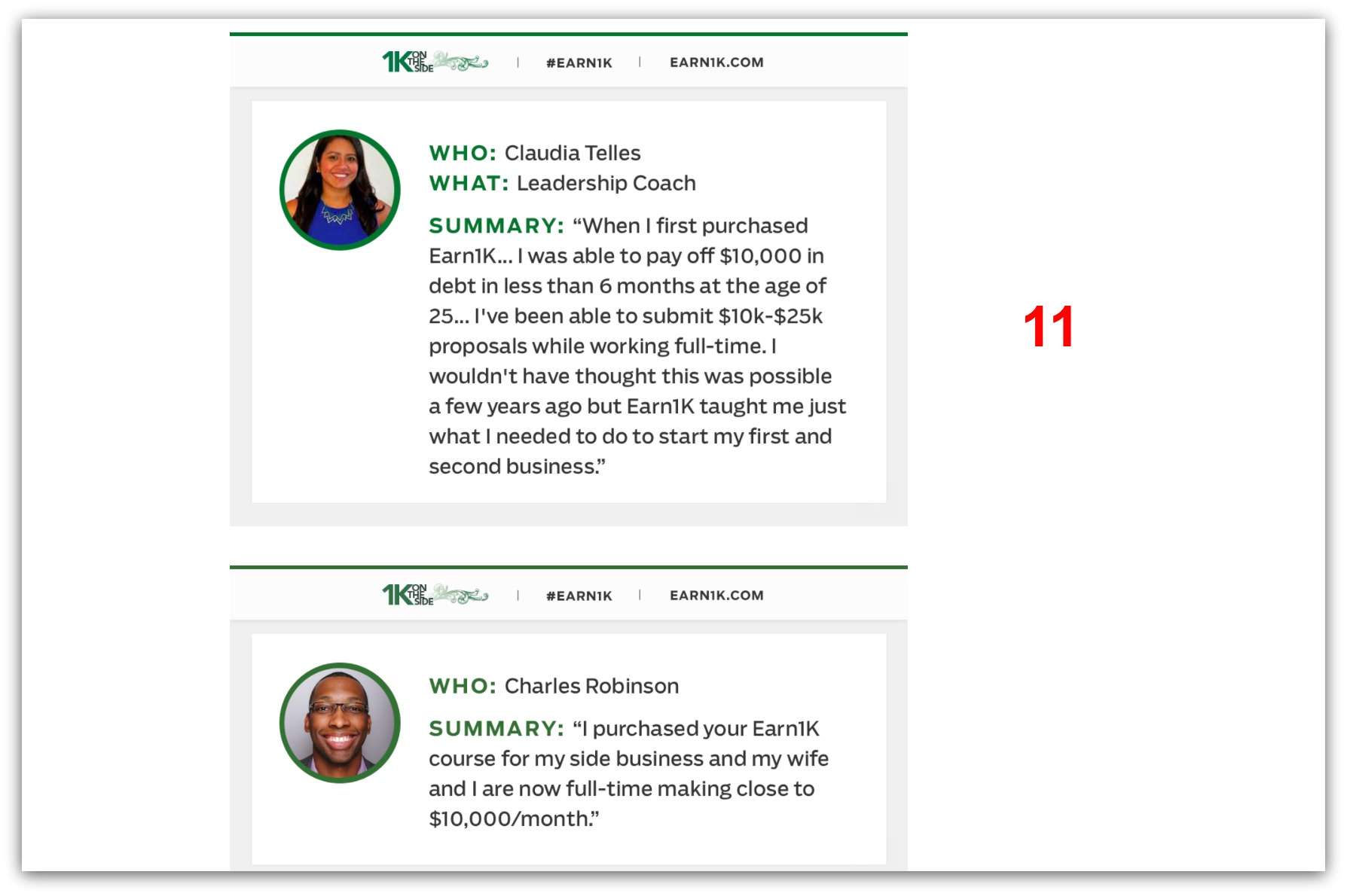
11. Testimonials. He follows that strong emotional appeal with more stories of success. He wants you to visualize yourself as one of these successful students. That visualization brings the reader closer to absolutely wanting to purchase. This…ah, this goes on for 10 or so testimonials. I’ll skip to the end of the email.
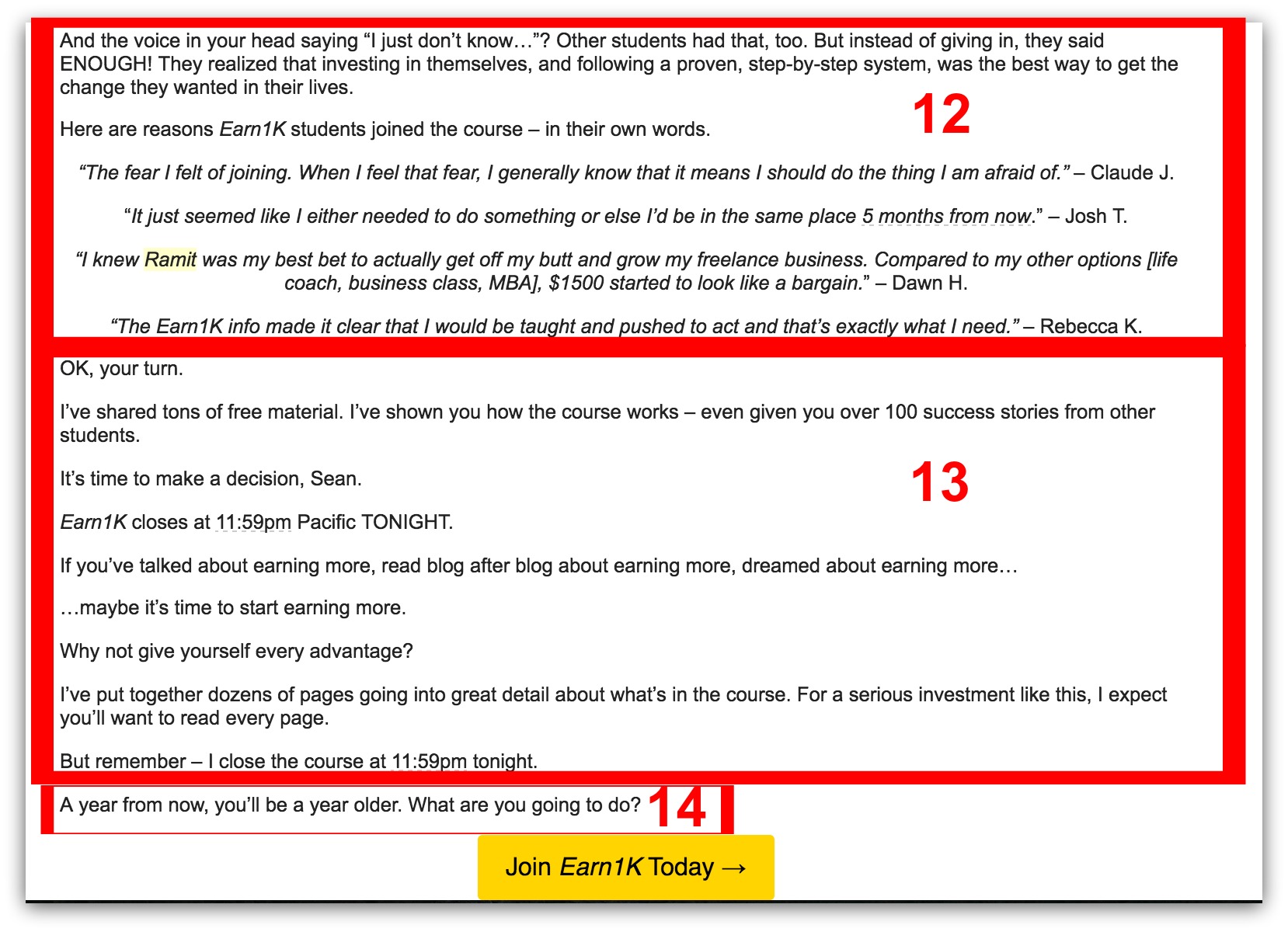
12. Visualization and testimonials. Here’s a less image-based way to inspire visualization through testimonials. Ramit talks about change, implicitly referring to the reader wanting change. Then he follows that claim for change with testimonials of students saying why they joined. Those reasons, coming from students instead of Ramit, carry more weight because the reader can identify more with the students.
13. Urgency appeal. Two last reminders of the offer ending soon. Honestly, this email could’ve had one or two more sprinkled in, with an extra link or call to action to make the purchase more accessible. Still, these last two reminders drive the point home that the reader has a decision to make, and quickly.
14. Gut check appeal. This last line is straight up something out of a motivational movie. It’s the stuff that you can whisper to a middle-aged man and send him into a crippling mid-life crisis. If the reader has any sort of doubts, fears or small insecurity about where they are in life, this line steeped in FOMO will make them seriously consider buying.
Notice how Ramit doesn’t give near as much detail about the course in this email as he did in the initial email. The recap email is all about emotion and making you feel like you’re missing something big if you don’t buy.
But at its core, this email is the same as a medium recap email. And even Ramit cheats a bit by repeating his structure halfway through the email — just with a different angle. It goes to show that once you master the elements, you can plug and play them anywhere to make a unique email.
You read this far? Here’s a gift
If you made it to this part, congratulations! You’re about to write some world-class sales emails that grow your business. And you didn’t even have to pay anyone or read a book. That’s a tally in the win column, yeah?
As a gift, I want to give you two things:
-
This entire guide in eBook form: I want you to be able to quickly reference this guide whenever you write emails. That’s why I’ve turned this guide into a handy eBook that you can keep forever, for free.
-
Email templates from the pros: You’ve seen a lot of successful emails in this guide. I’ve turned almost all of them into templates you can use to write emails just like everyone in this guide.
All you have to do is click here to grab those two FREE gifts. Enjoy!
Add A Comment
VIEW THE COMMENTS